We have a strict honesty policy, but please note that when you buy through our links, we may earn a commission. Learn more.
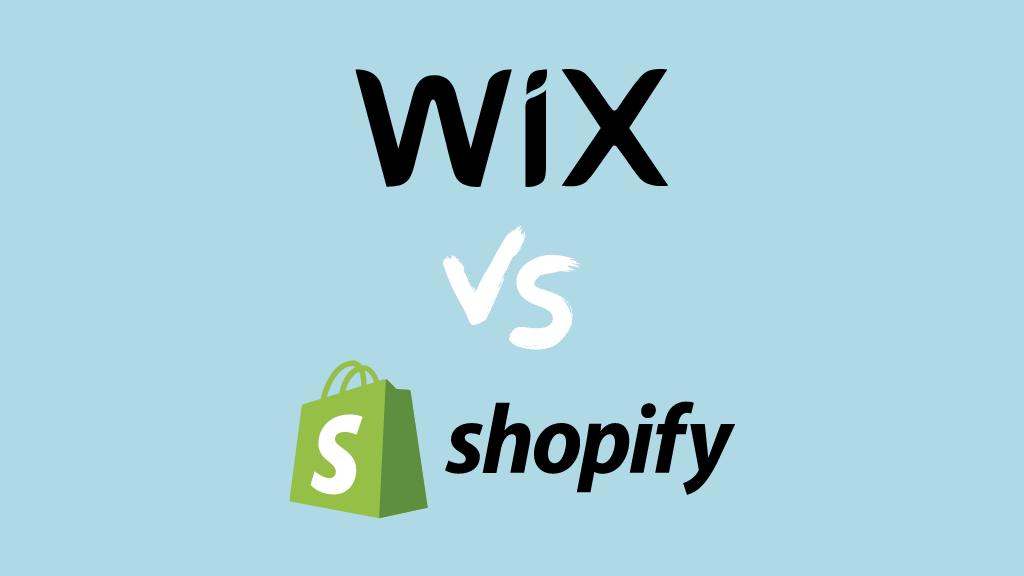
In this Wix vs Shopify comparison, I take a look at two of the best-known ecommerce solutions on the market and help you work out which one is better for your project.
Let’s start with a bit of background on both platforms.
Wix and Shopify: the background
At first glance, Wix and Shopify look like very similar tools, promising to give you everything you need to build a website or online store — and without needing to code.
And both have very large userbases: there are an estimated 8.6 million live websites powered by Wix, and 5.5 million powered by Shopify (source: Builtwith.com).
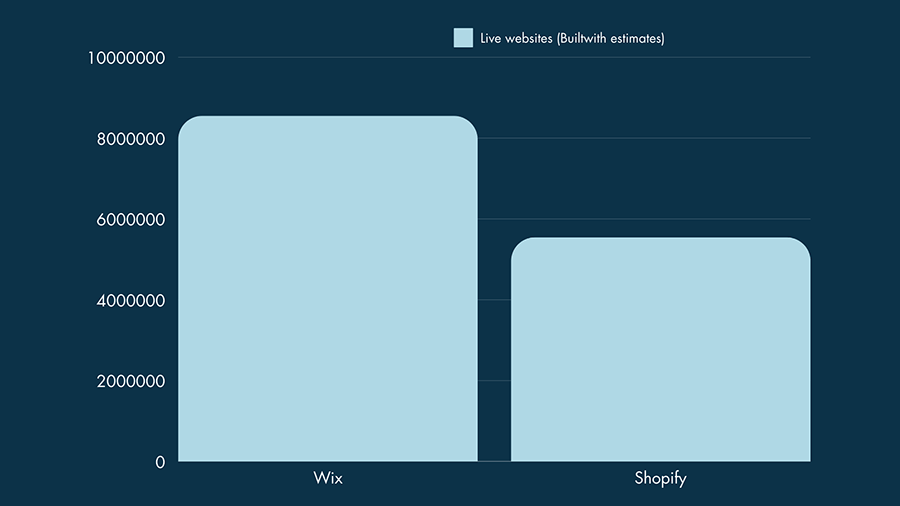
But both of these platforms started life with very different purposes in mind.
Wix was initially conceived as a solution for building content-based websites, for those wishing to create:
- brochure sites
- blogs
- photography portfolios
- news sites
…and other websites where conveying information or showcasing content was the key priority.
By contrast, Shopify was specifically designed to be a solution for starting an online store – and accordingly, all its features have always been 100% geared towards selling products.
But over the years, both products’ feature sets have changed considerably — Wix has evolved into a platform that now offers a lot of selling features, while Shopify’s content management tools have become considerably more sophisticated.

This means that you can now use either tool to create a content-driven website or an online store.

But which is better for your project?
Let’s find out — starting with a look at pricing.
Wix and Shopify pricing
The most significant difference between Wix and Shopify’s approach to pricing is that while all Shopify plans involve fees, Wix offers an entirely free one.
Shopify does give you a free trial, however. It’s on the short side — just three days — but Shopify is currently testing a new system that lets you extend it to three months at a cost of $1 per month. This 90+ day extension — which may not be around indefinitely — can be accessed via this special link.
Now, Wix’s free plan is very limited in functionality. You can’t sell anything with it, or connect a domain to it — and it’s got hard-to-avoid Wix ads on it (see screengrab below for an example of these).
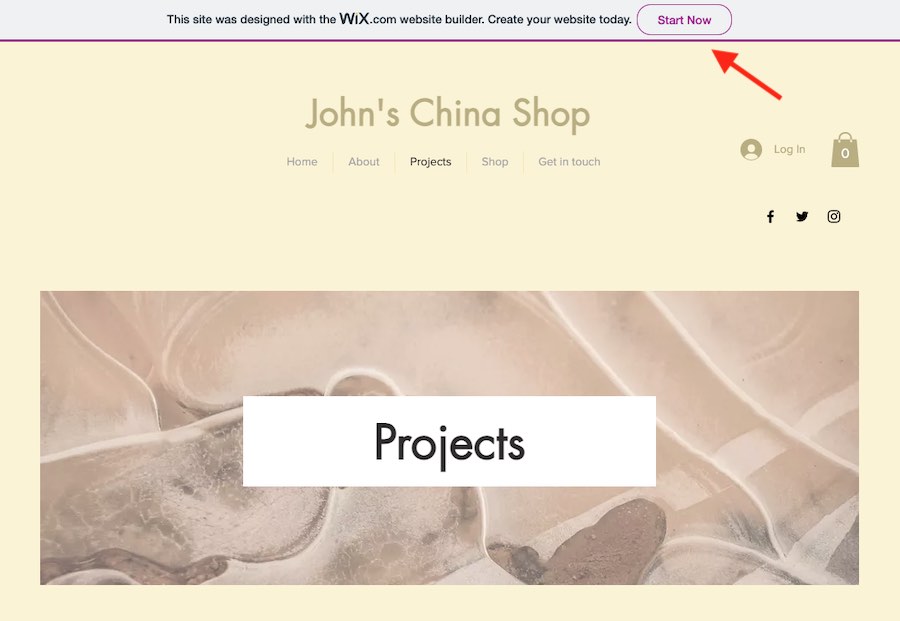
But even so, the free plan gives you a good way to ‘sense-check’ Wix and try it out.
To get the most of Wix though, you’ll really need to go for a premium plan. Which brings us onto…
Wix pricing
There are five Wix pricing plans available:
- Light — $17 per month
- Core — $29 per month
- Business — $36 per month
- Business Elite — $159 per month
- Enterprise — negotiable
The main differences to watch out for with regard to the Wix premium plans are:
- Storage space (for text, video, images etc.) — this varies according to plan, with the more expensive plans offering more of it.
- Access to apps — on the Wix ‘Core’ plan or higher, you get the ‘Events Calendar’ app and an SEO app, ‘Get Found Today,’ bundled with your main Wix subscription.
- Forms — you can create more data capture forms (containing more fields) on the more expensive Wix plans.
- Ecommerce features — if you’re using the ‘Light’ plan, you can’t access these. Additionally, you get more selling functionality on the more expensive plans (higher tax calculation limits, better dropshipping features etc.).
- Support — priority support is only available on the ‘VIP Business Elite’ and ‘Enterprise’ plans.
It’s probably fair to say that the best-value Wix plans are the ‘Core’ and ‘Business’ plans, as their feature-to-price ratio is good, and both plans cover the basics for those needing a brochure website or online store respectively.
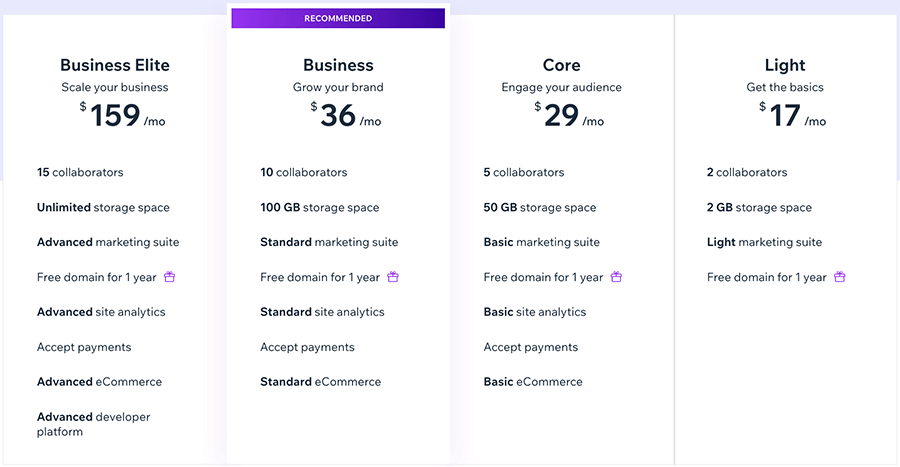
A quick note about the ‘Wix Enterprise’ plan: as the name suggests, this is geared towards more corporate users.
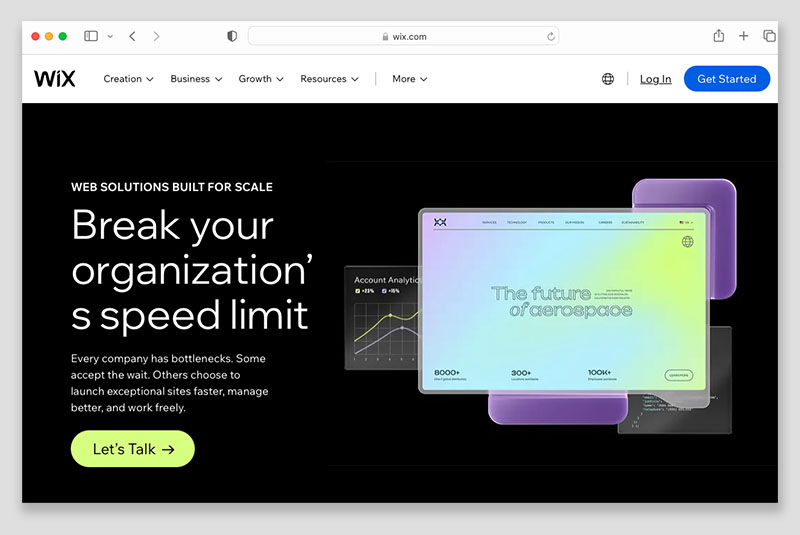
Fundamentally, the main difference between the Enterprise plan and the others is that it gives you a lot more hand-holding and access to consultants. And, unlike the other Wix plans, there’s no fixed pricing for it — it is negotiable and based on requirements.
Shopify pricing
As with Wix, there are five Shopify pricing plans to choose from:
- Starter — $5 per month
- Basic — $39 per month
- Shopify — $105 per month
- Advanced — $399 per month
- Shopify Plus — fees are negotiable, but in the region of $2,300 per month.
As discussed above, unlike Wix there is no free plan available for Shopify. A free trial is available however, which you can access here.
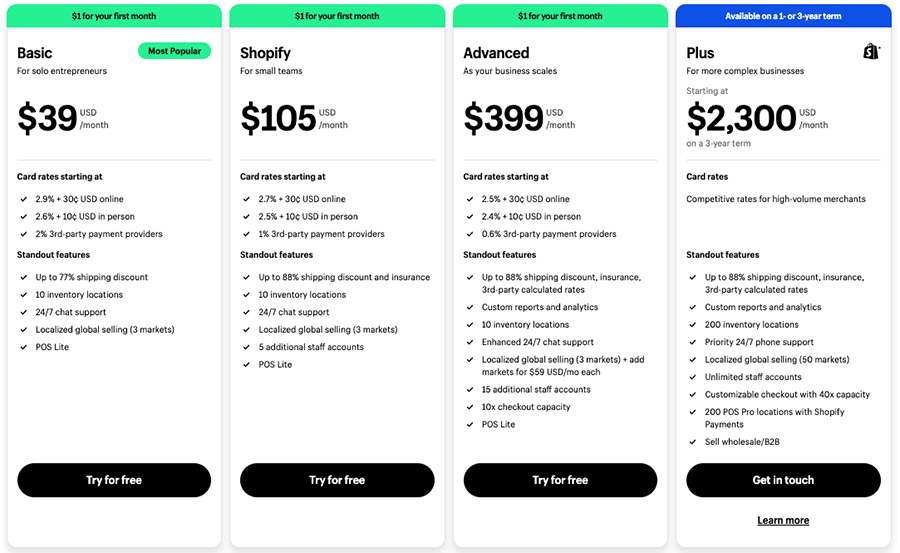
At the cheapest end of the Shopify pricing spectrum, you’ll find the Shopify ‘Starter’ plan. At just $5 per month, this plan makes Shopify cheaper to get going with than most online store builders, including Wix.
But it’s important to note that the ‘Starter’ plan doesn’t allow you to construct a fully-functional, standalone online store or sell in physical locations using a card reader.
Instead, it:
- gives you a simple storefront that you can use to display products (but not other types of content)
- lets you sell via your Facebook page and other social profiles
- allows you to sell via messaging apps (WhatsApp, Messenger etc.)
- gives you access to Shopify’s Buy Button, which allows you to sell goods on an existing website, social media profile or blog.
- accept payments in physical locations like retail outlets, market stalls, pop-up shops etc. (i.e., at ‘point of sale’).
The key differences between the other Shopify plans involve:
- the number of users who can access an account — the more expensive the plan, the more ‘seats’ you get
- professional reporting — this is only available on ‘Shopify’ or higher plans
- third-party shipping rate calculations (available on the ‘Advanced Shopify’ plan)
- multi-currency features — on the ‘Advanced’ plan, you can apply duty and import taxes, and access more extensive custom pricing features
- shipping insurance — merchants can avail of shipping insurance (to the value of $200) on ‘Shopify’ plans or higher
- checkout capacity — the number of checkouts you can facilitate per minute increases the higher up the pricing ladder you go.
Like ‘Wix Enterprise,’ Shopify Plus is pitched as an enterprise-grade solution that offers advanced features involving security, APIs, task automation and fulfilment.

The fees for Shopify Plus are negotiable, but the product is very expensive — you can expect to pay around $2,300 per month for it. However, it is a truly enterprise-grade solution that is used by big corporates like Sony, Pepsico, Heinz and Unilever. Whether you can truly say the same about the ‘Wix Enterprise’ plan is debatable.
📚 Related resource: You can learn more about the differences between Shopify and Shopify Plus here.
Transaction fees and credit card rates
In addition to monthly fees, there are also transaction fees and credit card fees to consider. And it’s important to understand the difference between both.
- Transaction fees are a percentage ‘cut’ of your sales taken by online store builders.
- Credit card fees are the charges applied by your payment processor (or ‘payment gateway’) each time one of your customers buys a product via credit card.
With both Wix and Shopify, you can avoid transaction fees if you use their built-in payment processors, Wix Payments and Shopify Payments respectively.
(One caveat here: this does not apply to the Shopify ‘Starter’ plan. A large 5% transaction fee is applied to each sale made on this plan, regardless of how you process payments.)
Furthermore, Shopify Payments is only available in certain countries. So, depending on your location, you may have to use a third-party payment gateway — and Shopify charges you to do so.
On the ‘Basic’ plans or higher, Shopify will apply transaction fees of 0.2% to 2% per sale for using a third-party payment gateway, depending on the plan. On the ‘Starter’ plan the rate is 5%.
Wix doesn’t charge you at all for using a third-party payment gateway, so it’s a win for Wix here.
As for credit card processing fees, the Wix Payments and Shopify Payments charges are as follows:
- Wix Payments: 2.9% + 30c in the US.
- Shopify Payments: 2.5% + 30c to 2.9% + 30c in the US, depending on plan.
(These processing fees can be a lot lower in other countries, however, and are slightly lower where in-person sales are concerned.)
Custom domain names
It’s worth pointing out that if you pay on an annual basis for any Wix plan, you get a free custom domain name for your first year of service (i.e., yoursitename.com).
Shopify lets you register domains using its platform too — but doesn’t provide them for free.
Some quick conclusions on Wix vs Shopify pricing
For me, the bottom line on Wix vs Shopify pricing is this: if you’re hoping to build a ‘general’ website showcasing content rather than products, then with its entry-level plan’s pricing of $17 per month, Wix is considerably better value.
But in order to make a call on which of these two products offers more value from an ecommerce point of view, you’ll need to drill down into the quality of selling features available in each — and as we’ll see shortly, it’s in this area that Shopify brings some really strong functionality to the table.
I’ll walk you through all of Wix’s and Shopify’s key ecommerce features in just a moment — but before I do that, let’s look at something that a lot of people understandably prioritize when choosing a website builder: visuals.
Templates
At the heart of Wix and Shopify’s approach to web design is a set of pre-designed templates.
(In Shopify, these are referred to as ‘themes’).
You pick one of these templates, add some text and images to it, and it forms the basis of your site or store’s design.
Your template should be thought of as a ‘starting point’ — its default colors and the typefaces included with it can all be changed to match those of your brand.
Quantity of templates
When you create a Wix account, you get to choose from 920 bundled templates. This is considerably more than the 13 free themes included with Shopify.

That said, if you’re not happy with the limited range of free Shopify themes, there is always the option to purchase a premium theme for a one-off fee. There are 217 of these available, ranging from $100 to $500 in price.
💡 Tip: You can view all the Shopify templates, both free and paid, here.
It’s worthing noting that these premium Shopify themes tend to come in a few variants, extending the template choice available from Shopify a bit further.
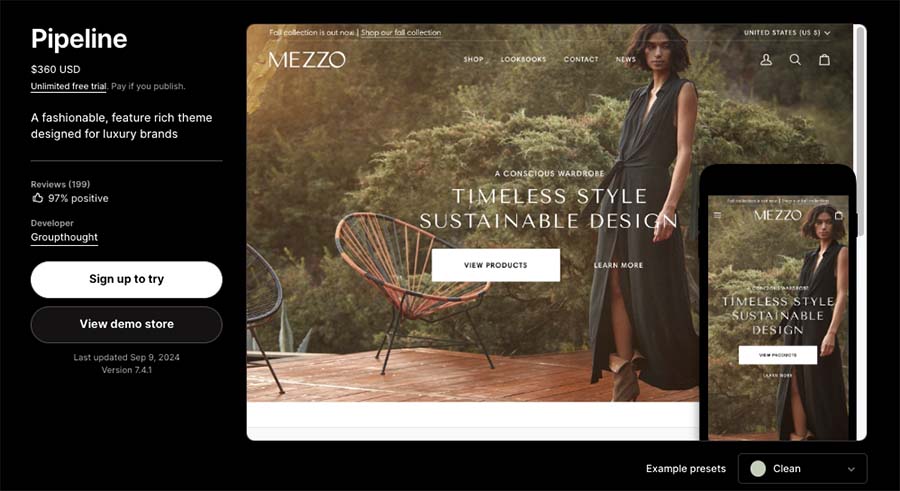
But ultimately, in terms of the quantity of templates, Wix is the winner — and you can view its template range here.
What about the quality, though?
Quality of templates
In terms of quality, both platforms’ set of templates are professional in appearance and contemporary in design.
As you might expect, Shopify’s themes are geared firmly towards ecommerce, and are arguably more robust for use in that context.
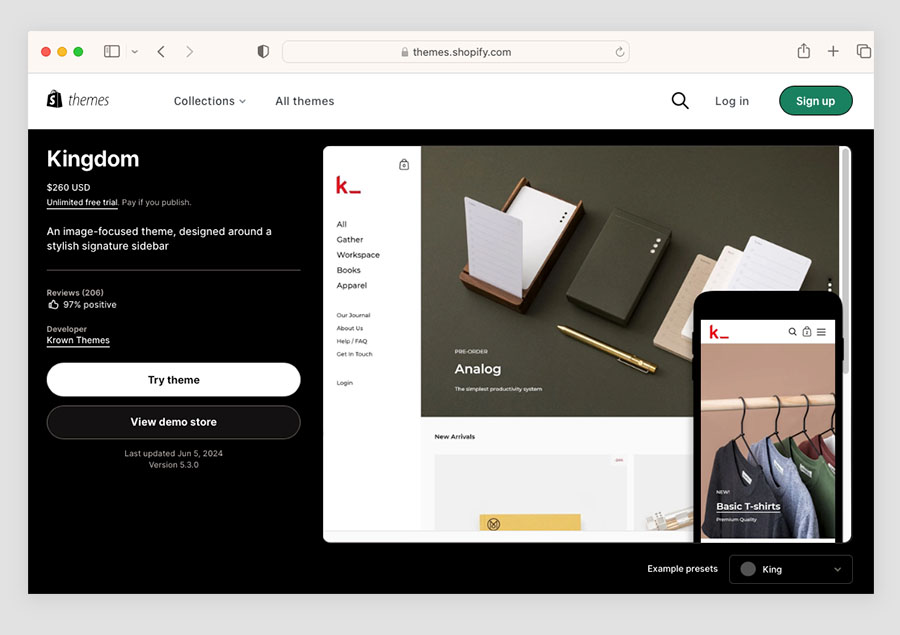
Wix offers a much greater range of general purpose templates, though — so if your aim is to build a content-driven site, and sell ‘on the side,’ there’s a lot more on offer from Wix.
Additionally, you can start with an entirely blank template in Wix — this may suit more creative users who want to avoid a ‘cookie-cutter’ style approach to designing an online store.
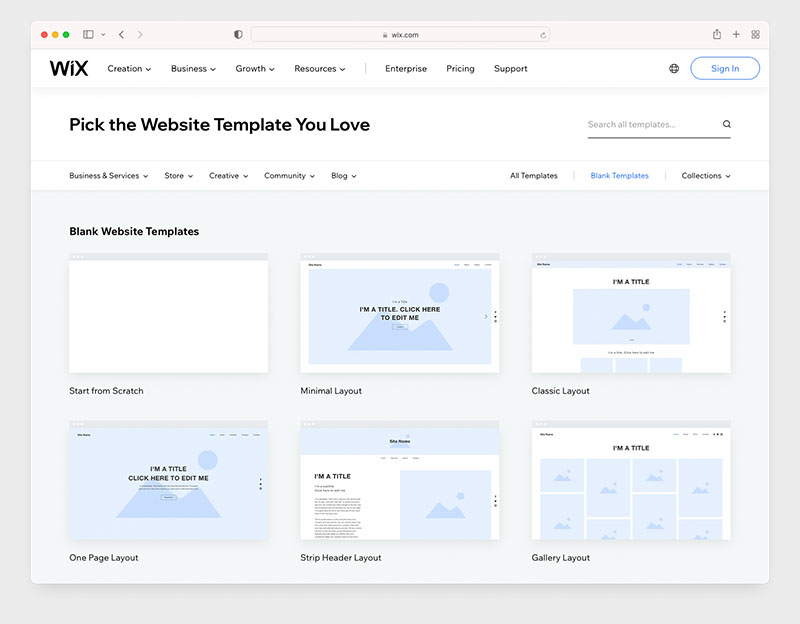
The bottom line on template quality is that if you’re looking for a dedicated ecommerce template, Shopify arguably provides you with stronger templates – but to get the best Shopify themes, you will have to pay a bit extra.
Template performance on mobile devices
Shopify’s templates are all 100% responsive, meaning that their components — text, images, forms etc. — will automatically resize themselves to suit the device that they’re being viewed on (for example a desktop computer, mobile, or tablet).
Wix, by contrast, uses a design approach called absolute positioning, where web elements are positioned by pixel.
In practice this means that you have to create two versions of your Wix website — one for desktop, and one for mobile. This means more work for you as an end user.
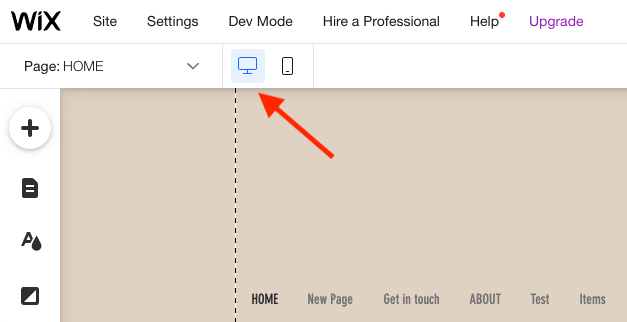
That said, Wix does a pretty good job of sorting the mobile version out automatically for you — you won’t always have to change it, especially if you are making minimal edits to a template.
However, there will inevitably be times where you have to tweak the mobile version of your Wix site a bit to ensure that it displays correctly.
Now, this is not always a bad thing. A benefit of being able to edit both the desktop and mobile versions of your site is that you can create a more streamlined version of your mobile site, by hiding elements that might feel a bit superfluous for smartphone users.
(This isn’t really possible on a Shopify store without resorting to coding.)
But ultimately I do prefer responsive templates to those that make use of absolute positioning. Absolute positioning goes against best web design practice; and significantly, it goes against Google’s advice on creating a search-friendly mobile site too.

To be fair to Wix however, the company is making ongoing efforts to improve the performance of its sites on mobile devices, and is gradually introducing more responsive elements to them. And Google is on record as saying Wix sites generally work fine from an SEO perspective.
So ultimately, Wix’s approach to displaying content on mobile devices shouldn’t be seen as a showstopper. But if you’re working in an ultra-competitive niche, you may find that there is currently a bit more SEO value in Shopify’s approach to template design.
ℹ️ There is a different version of Wix available, Wix Studio, that does facilitate responsive design. This is currently aimed at developers and agencies rather than general users, however.
Styling and switching templates
When it comes to styling or switching templates, Shopify is a hands-down winner over Wix.
First, you get full access to the CSS and HTML code of your template in Shopify.
This is not the case in Wix — although you can add CSS in Wix, you can’t edit the general stylesheets. Similarly, you can add HTML code blocks to a Wix web page, but not edit the general code of your site.
Additionally, Shopify makes it extremely easy to switch templates. With Wix, if you get bored of your site’s template, and want to switch to another one, you will have to rebuild your whole site to do so.
So if it’s design flexibility or future-proofing you’re after, the better choice is definitely Shopify.
But what about actually using the platforms?
Content management and interface
Ease-of-use
Wix provides 3 interfaces for building websites:
- Wix ADI
- Wix Editor
- Velo by Wix
When you create a new Wix website, you are prompted to choose between ‘Wix ADI’ and ‘Wix Editor.’
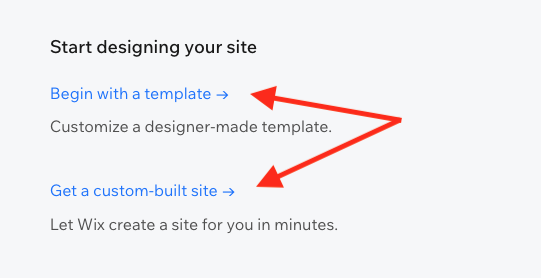
‘Wix ADI’ mode (‘Artificial Design Intelligence’) automatically creates a customizable website for you complete with images, video, and text. This is done by asking you a few questions about what you’re trying to achieve, and then populating your site with publicly-available information about you or your business from the web.
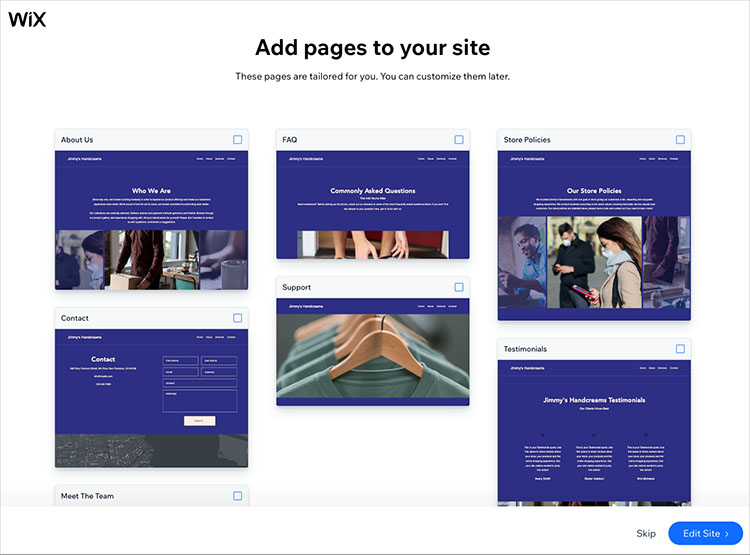
How good the content Wix ADI pulls is a bit of a hit-and-miss affair really, and will depend on the quantity, quality and relevance of information Wix finds about you or your business online.
Wix ADI is extremely simple to use, however — so even if it doesn’t quite pull the appropriate content for your site, what it does present will be easy to edit.
The ‘Wix Editor’ option lets you pick a template, create a structure for your site, and then populate it with content. Wix Editor gives you a lot more control over how your site looks and functions than the ‘ADI’ version – and in my view, is probably the best version of Wix for most users.
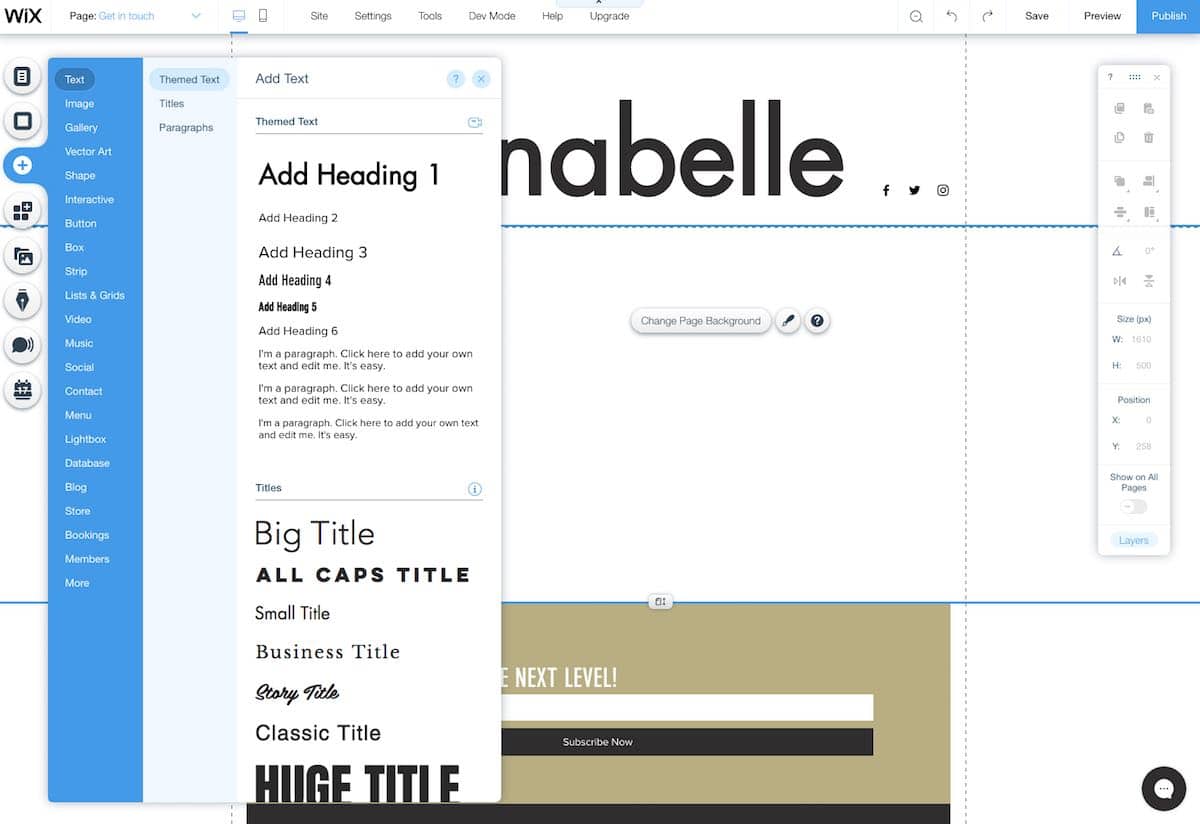
Finally, there’s ‘Velo,’ which is a ‘full-stack development platform’ for Wix. This provides access to Wix’s APIs, enables the addition of greater functionality to Wix sites, and gives you more control over design. You will need development skills to use this version of Wix, however.
Regardless of which of the three versions of Wix you use, the process involved with adding or editing content is similar across the board. Simply put, it’s equivalent in complexity to using Microsoft Word or Google Docs. You just select the copy or content you’d like to edit, and change it accordingly. It’s all fairly intuitive.
(You get more flexibility in how you can lay out or move content around pages with Wix Editor and Velo, however).
With Shopify, there’s just one interface — depending on the Shopify plan you’ve picked, the features and settings available in it will differ slightly, but it behaves consistently regardless.
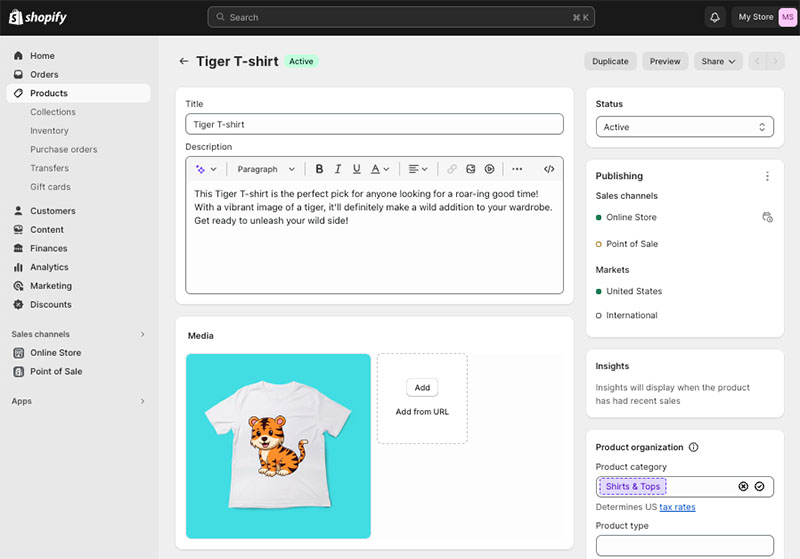
The main difference between managing content in Wix vs Shopify is that with Wix, you’re nearly always working with a drag and drop editor. This means that you see your edits on your screen as you make them — and get you an immediate sense of how your changes will affect your design.
But with Shopify, for most page types, you still have to input content using a rather old fashioned ‘WYSIWYG’ (‘What You See Is What You Get’) editor.
However, with the rollout of a new theme editor — Online Store 2.0 (OS 2.0) — the platform lets you edit certain aspects of your site using a drag-and-drop editor, namely:
- your home page
- page templates
Shopify’s new drag and drop editor works a bit differently to Wix’s, though. While Wix’s editor lets you drop anything anywhere on the page, Shopify’s locks things down a bit more tightly — you are dealing more with predefined blocks and sections that you move up and down a page.
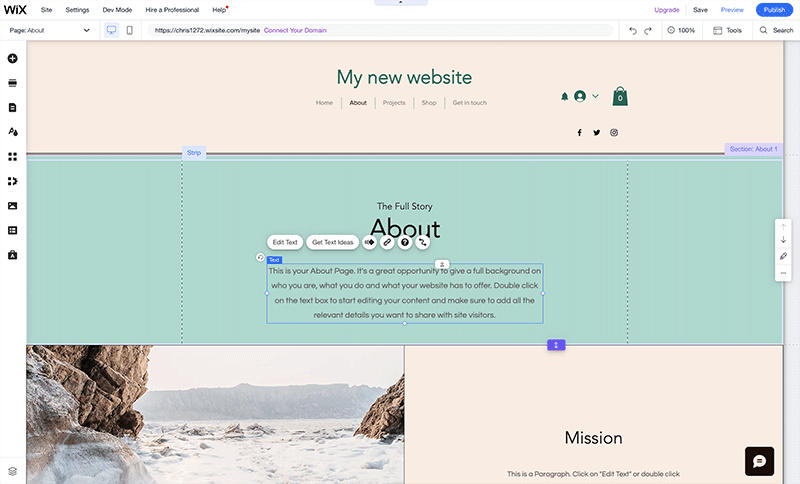
This may be a bit more restrictive, but it does mean that your store design remains fully responsive and 100% smartphone friendly.
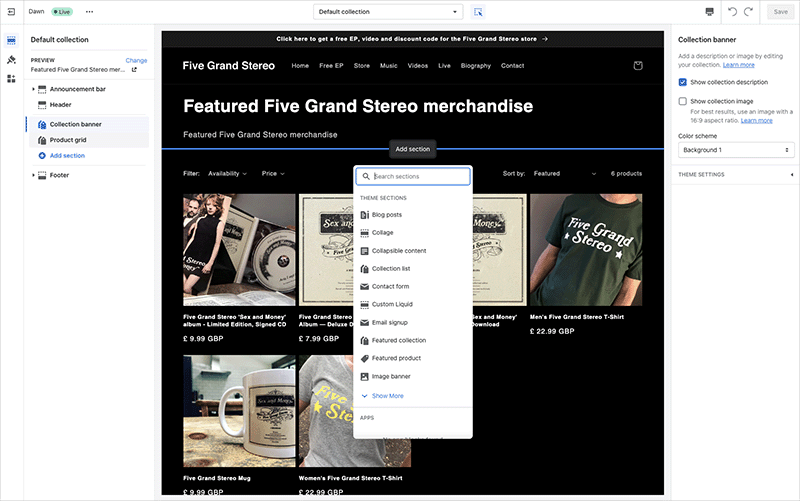
Another key difference between working in Wix and Shopify — and as discussed above — is that in Wix you are working with two versions of your site, a desktop one and a mobile one. This gives you much greater control over the appearance of both — but can also mean more editing.
Ultimately, when I tested both platforms, I didn’t feel that either presented a particularly steep learning curve when it came to editing a website. Some users will prefer the immediacy and flexibility of the Wix front-end editor to Shopify’s preview-and-publish approach, but others will appreciate the more rigorous ‘snap-to-grid’ approach taken by Shopify.
CMS features in Shopify and Wix
The key thing to note about the Shopify and Wix content management systems is that the former’s is very much focused on ecommerce, while the latter’s is more about website building in general.
This is reflected in both platforms’ content management systems (CMS) — you’ll find that you get a much wider range of website building components to choose from out of the box with Wix.
These include galleries, social icons, forms, media players, content strips and many others — you can pick one of these and then drag and drop it anywhere you like on your page.
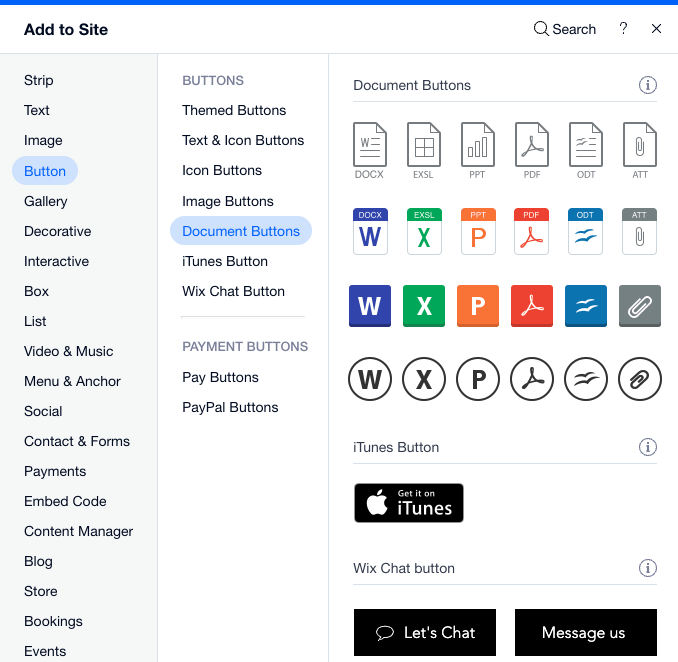
In Shopify, you won’t find as large a range of ‘content components’ to add to pages — you’ll often have to resort to adding an app to get some of the functionality that’s provided by Wix.
A key example of this involves forms. Out of the box, the Shopify forms are extremely basic, and you’ll usually need to install the ‘Shopify Forms’ app (or similar one) to get the functionality you need — popup features, customizable fields, bespoke layouts etc.
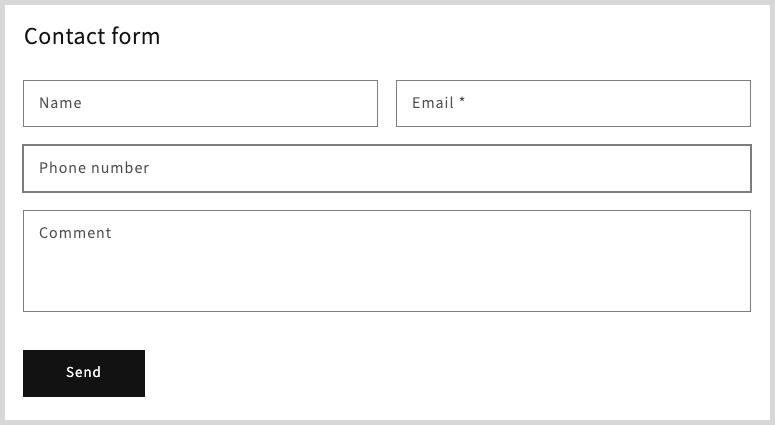
The other thing to note about Shopify is that you can’t move the components that are available around your site as easily as you can in Wix (on the plus side, and as discussed above, this helps ensure that your website remains fully responsive).
This more restrictive approach might explain why Shopify’s CMS is a lot faster, however; I’ve found the Wix interface to be rather slow at times, and have had to stare at ‘loading’ animations for ages whilst waiting for particular features to load. By contrast, everything happens fairly instantaneously in the Shopify CMS.
To sum up: Wix’s CMS, in many ways, is much more flexible — but it’s also more fiddly and slow, and the sheer number of website building components available can feel a bit overwhelming.
Overall, I generally prefer the cleaner, ‘walled-garden’ approach of Shopify’s CMS — but I think improvements could definitely be made to its drag-and-drop editor.
Blogging in Wix and Shopify
Both Shopify and Wix allow you to create a blog for your site. This is an essential feature for anybody who is serious about growing their online business, because high-quality blogging is one of the best ways you can increase site visibility in search results and attract inbound traffic to your website.
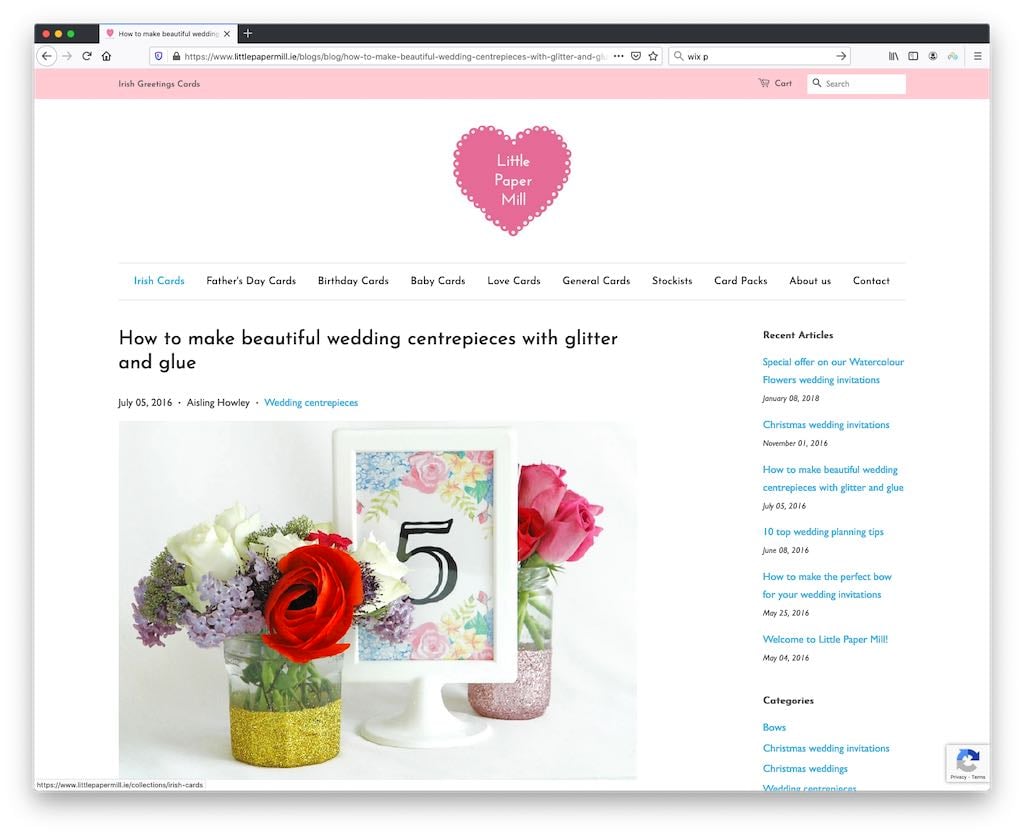
The blogging functionality in both Shopify and Wix is fairly similar — you can create simple posts and categorize them as you please.
Additionally, RSS feeds are available for both Shopify and Wix blogs — these allow other people to subscribe to them easily, or feature your blog content on their sites.
Wix has an edge in the blogging department however, because it has an autosave feature that prevents you losing content should your computer crash or your internet connection drop.
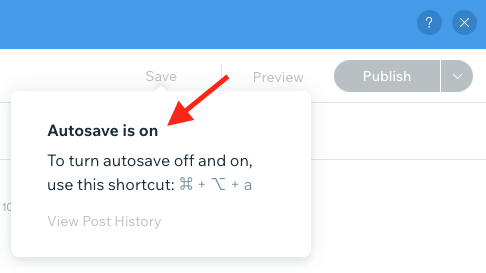
Additionally, Wix lets you use both categories and tags in your blog posts — but Shopify only lets you use tags.
So, a clear win in the blogging department for Wix.
Using AI to help you create content
Wix and Shopify have both recently embraced generative AI, adding features that produce content (page copy, blog posts, product descriptions and images) based on keywords and instructions you provide.
Wix’s AI features include an text creator, image editor, image creator and background removal tool. Shopify has a similar suite of tools all tagged with a slightly jazzier name — ‘Shopify Magic.’
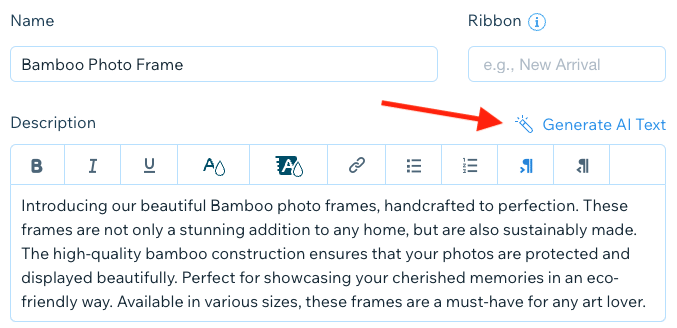
Most of Wix and Shopify’s AI tools work in a pretty similar way, and are in fact built using the same tech: the ubiquitous ChatGPT.
However, Shopify’s AI tools are arguably a bit more useful when it comes to ecommerce. This is because unlike Wix it gives you access to AI-powered customer spend predictions, along with simple AI analysis of any customer segments you create.
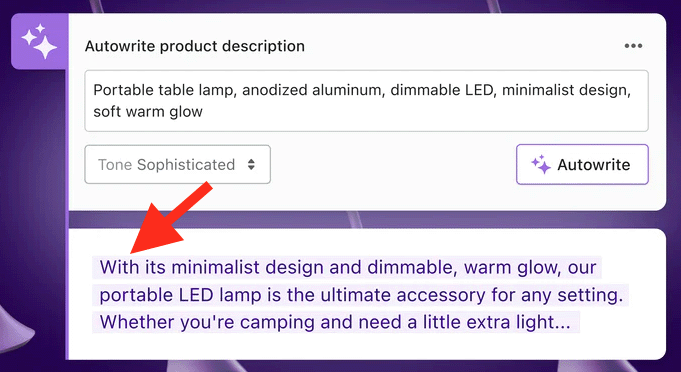
Mobile apps
Wix and Shopify both allow you to manage your store on the go, via mobile apps.
Wix’s mobile app is called ‘Wix Website Builder.’ It can be used to create and edit site content or manage inventory, and US or Canadian users can also use it for basic point-of-sale applications — i.e., to take payment for goods in a physical location like a pop-up shop or market stall.
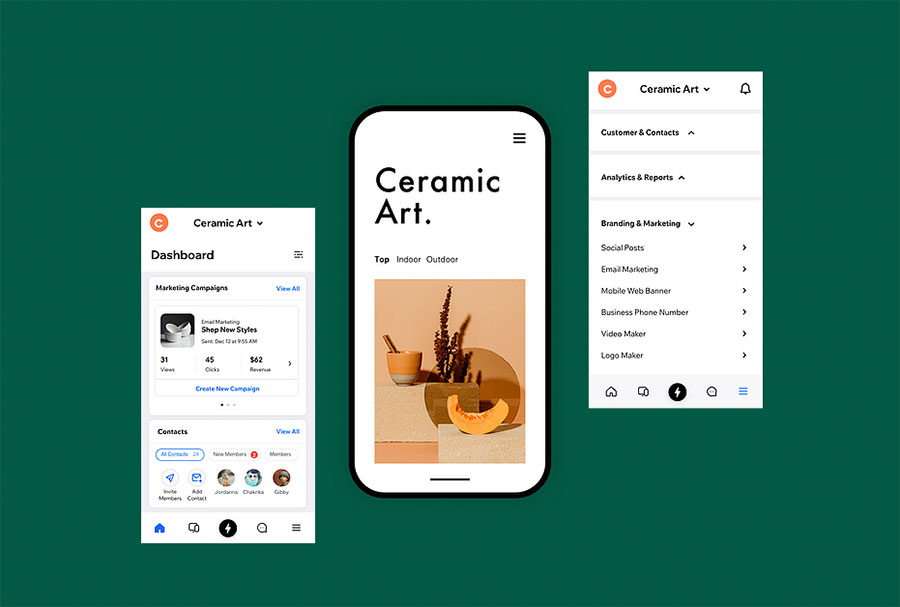
There are actually quite a few mobile apps available for Shopify, but the key ones are:
- Shopify
- Shopify POS
The Shopify app is a general-purpose app that lets you manage your store on the go; and, as its name suggests, the Shopify POS app is for Shopify users who are working in a ‘point-of-sale’ context (a physical location like a market stall or retail outlet) and need to take payment or sync inventory using their mobile device.
In terms of ratings, users rate the Wix mobile app 4.7 and 4.1 out of 5 on the iOS and Google Play stores respectively; the equivalent scores for Shopify’s main app are 4.7 and 4.3.
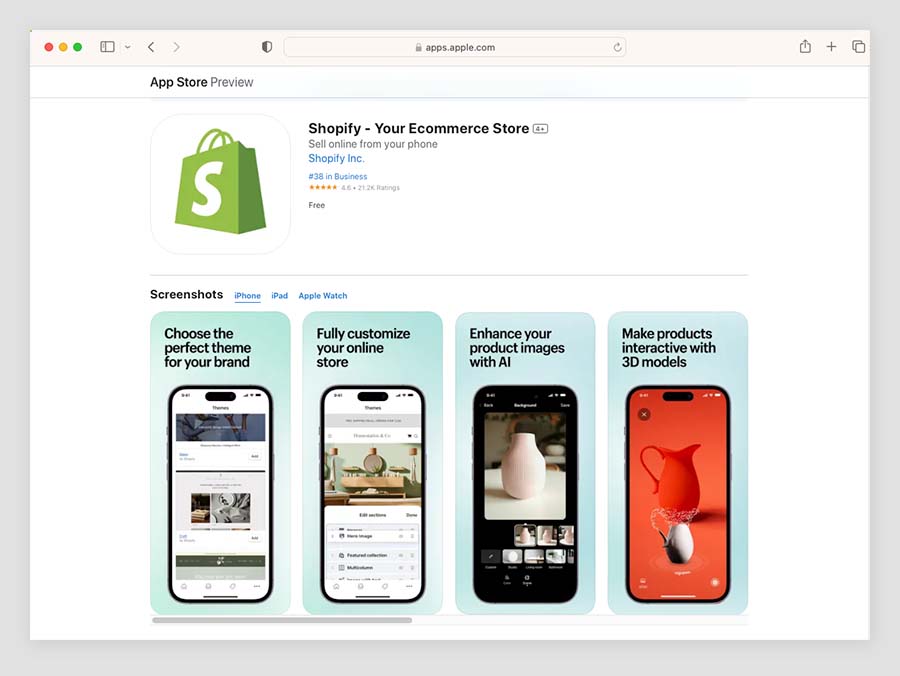
Depending on whether you’re an Android or iOS user, you can make use of other Shopify apps. These include:
- a customer chat app (‘Shopify Inbox’)
- a ‘digital shopping assistant’ app (‘Shop‘)
- a logo maker.
But it’s the main ‘Shopify’ app that is probably of most relevance to Shopify merchants.
In terms of which of the mobile apps are better, I’d personally argue — and this probably won’t come as a surprise by now — that the Wix app is better suited to those needing to make general edits to their website, and the Shopify apps are better suited to ecommerce.
And speaking of ecommerce…
Ecommerce in Wix vs Shopify
If you’re comparing Wix vs Shopify, you are probably especially curious about which of these products is the better option for selling online. So let’s compare their ecommerce features and find out, starting with payment processing.
Payment gateways
A payment gateway is the software you use to accept online payments. Both Shopify and Wix provide their own built-in payment gateways: Shopify Payments and Wix Payments respectively.
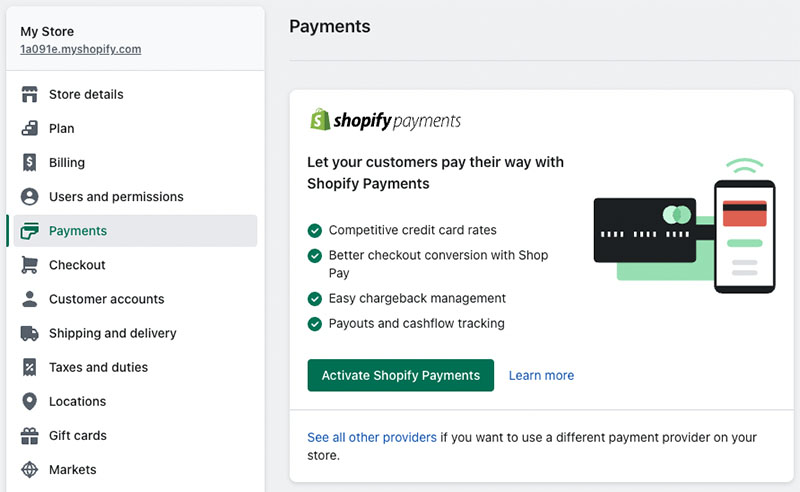
These are not supported in all countries however, so depending on where you’re located, you may need to resort to a third-party payment gateway.
Shopify has an edge here, because it integrates with a larger range of payment gateways: around 300 to Wix’s 87.
However, and as mentioned earlier, Wix gets a thumbs up for not charging you any fees at all for using a third-party payment gateway — Shopify, by contrast, applies transaction fees if you use one (these vary by location and plan type).
Product management
Importing and exporting products
Both Wix and Shopify make it pretty easy to import products — you can do this via CSV file, with both platforms providing you with a CSV template that you can populate.
(In the case of Shopify, you can also purchase a third-party app from its app store to import products from other store builders — the ‘Migration Pro’ app, for example. More on the Shopify app store later!).
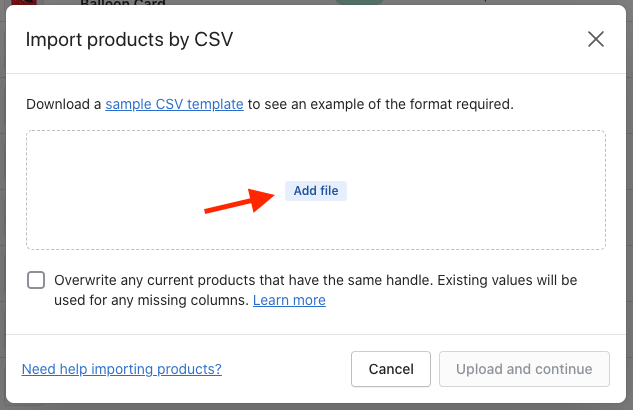
Wix complicates things here however, by capping the number of products you can import to 50,000, and applying a 5,000 limit to the number of products you can import via CSV in one go.
Shopify has an edge when it comes to exports, too — it’s easy to export all of your product data from the platform. With Wix, a limit of 5,000 products applies to exports – and you can’t export digital products.
Product options and variants
Both Wix and Shopify let you sell a large number of products — but Shopify technically lets you sell more of them. While Wix caps the number of items you can sell at 50,000, you can sell an unlimited amount of products with Shopify.
In practice though, both platforms will cater for most merchants’ requirements on the product quantity front.
However, if you intend to sell products that come in a lot of different shapes and sizes, a key thing to look at when comparing Wix vs Shopify is the limits placed on product options and variants.
Product options are things like size, color and material (‘large’ or ‘green’ or ‘cotton’); variants are the combinations of these.
So, for example, a large blue suede shoe would be one variant, a small red leather shoe would be another etc.
Wix has an edge over Shopify here, allowing you to make use of up to 6 product options and 1,000 variants.
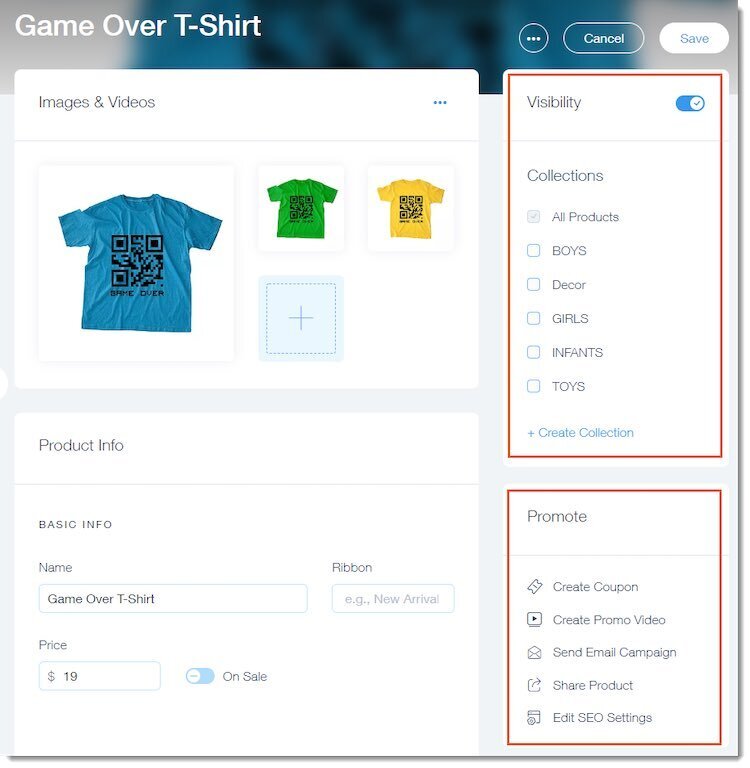
Shopify’s equivalent limits are 3 and 100 respectively, although you can install (paid-for) apps to your Shopify store that remove these limits. (And it’s worth noting that the Shopify variant limit is due to be increased to 2,000 in 2025.)
But for now, when it comes to product options and variants, the more flexible choice in terms of ‘out of the box’ functionality is Wix.
Product categorization
Although Wix currently offers more flexibility around product options and variants, Shopify is the better tool for categorizing your products.
Unlike Wix, it offers a really neat ‘smart categorization’ feature that lets you define rules that automate product categorization — you can for example define product categories based on things like product title and tag, and Shopify will automatically slot your products into these categories (a huge time saver if you are dealing with a huge range of products).
And second, Shopify lets you make use of an extensive range of predefined product categories and product options (a few of which are pictured below).
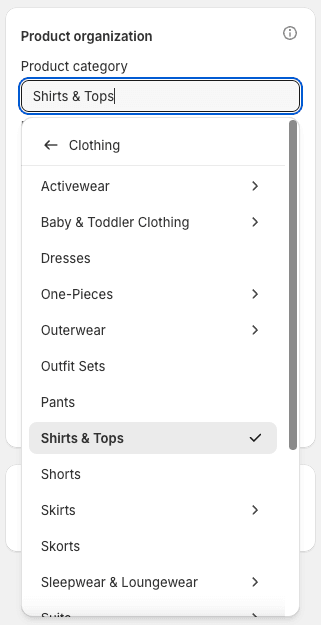
Using the example above, if you categorize the product as ‘Shirts & Tops’, Shopify will then surface the relevant attributes for that product (size, color, material and style) when you go to create product options for it.
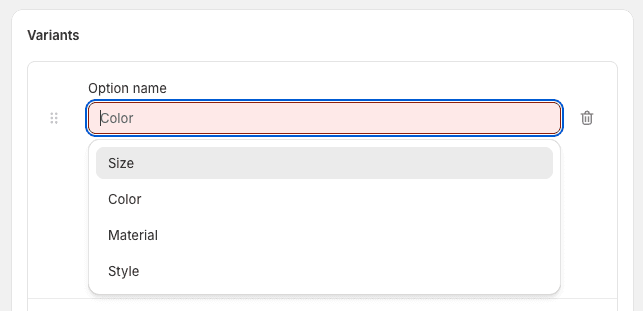
You can use these to generate variants.
Product customization / personalization
If you want to give your customers the option to customize their product — for example, by adding text for an engraving — Wix has an edge, because it’s easy to add a custom field to a product.
With Shopify you will need to add an app or add some code to your template to do this.
Dropshipping in Wix vs Shopify
Dropshipping is an approach to online retailing where you don’t keep what you’re selling in stock. Instead, you take an order via your store, send it to a supplier, and they deliver the goods to your client on your behalf. It’s an attractive, if competitive, method of selling goods online.
Shopify allows you to connect your store to a very large number of dropshipping companies via its app store — I counted 639 dropshipping apps in its app store (more on Shopify apps in a moment).
However, it’s hard to establish which of these dropshipping companies make their goods ethically — many of the products on offer in Shopify’s dropshipping apps are made in countries where working conditions can be very poor.
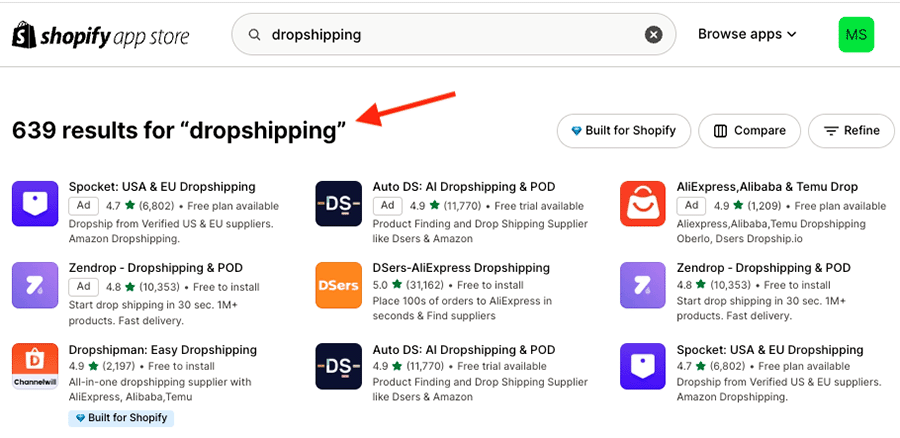
Up until relatively recently, you couldn’t dropship with Wix. However, over the past couple of years, the company has been rolling out some integrations with platforms that facilitate it.

My most recent search for dropshipping apps in the Wix App Market returned 65 results, which included integrations with key dropshipping suppliers like Modalyst, Spocket, Syncee, Printful and Printify.
Now, all Wix plans except ‘Light’ bundle an integration with the Modalyst dropshipping app — but the number of products you can dropship on them varies. The limits are as follows:
- Core — 25
- Business — 250
- Business Elite — 50,000
- Enterprise — 50,000
Ultimately, Shopify offers more choice in the dropshipping department, and indeed is the best option I’ve come across for dropshipping in general to date — but it would be great to see a list of ethical dropshipping companies and/or apps made available on the platform.
👉 See also: How to start a Shopify dropshipping business
Selling digital goods and VAT MOSS
In addition to letting you sell physical goods, Wix and Shopify both allow you to sell digital products (eBooks, music and so on).
I’ve found that doing so in Wix is slightly more straightforward, because you get this functionality out of the box — Shopify requires you to add its ‘Digital Downloads’ app first (there is no charge for this, however).
Despite the fact that you can get started with digital downloads a bit more easily with Wix, I’d argue that Shopify is — for EU users at least — the better bet for selling digital goods, because it handles an EU tax called ‘VAT MOSS’ more effectively.
VAT MOSS is a requirement that sellers of digital products to consumers in the EU add value added tax (VAT) to each digital product on a per-country basis (i.e., there’s one VAT rate to be applied for France, one for Germany and so on).
Unlike Wix, Shopify calculates the appropriate rate automatically — there’s no messing about with setting up manual tax rules and so on. This is an extremely useful piece of functionality, which for me makes Shopify a more obvious choice than Wix for merchants selling digital goods.
And on top of the neat handling of VAT MOSS, Shopify is more generous when it comes to file size limits — your digital goods can be 5GB in size, to Wix’s 1GB.
So all in all, if you’re setting up a store specifically to sell digital goods, I’d argue that Shopify is an excellent choice and a better option than Wix (or indeed competing platforms in general — of all the ecommerce platforms I’ve reviewed, I’ve yet to come across an online store builder that handles VAT MOSS rules better).
Point-of-sale functionality in Wix vs Shopify
Point-of-sale (POS) functionality allows you to use your online store to sell in the ‘real world’ — i.e., in a shop, at a stall, at a concert and so on. You can use POS to accept payments (usually via card readers that connect to a mobile device) and to handle inventory management (i.e., when you use POS to sell a product in a physical location, your online store’s stock levels get updated automatically).
For many years, Shopify has made POS a key feature of the platform, providing things like dedicated POS support, a hardware store and detailed reporting.
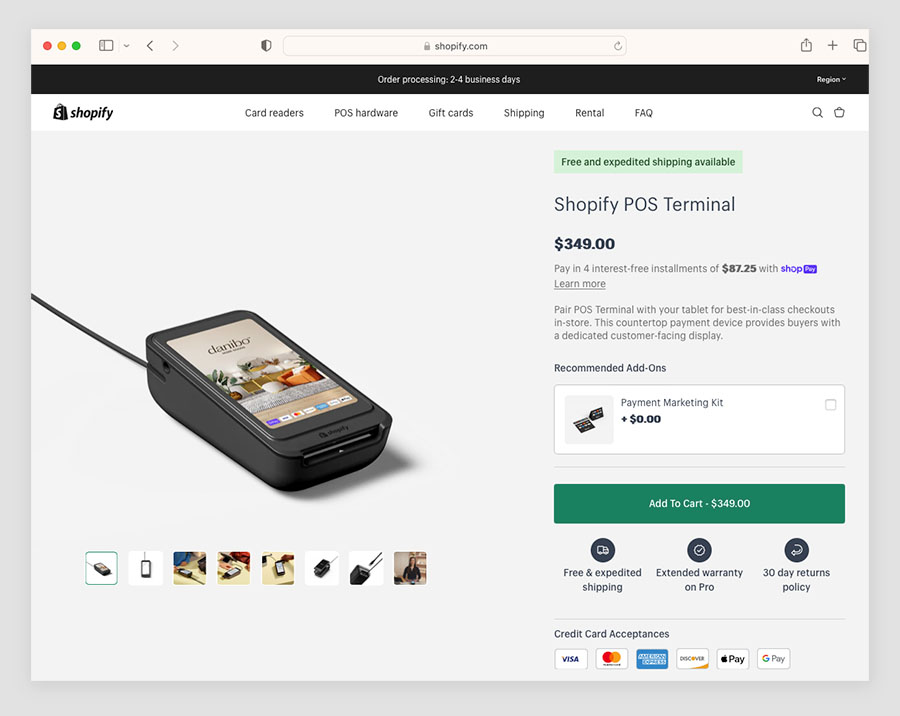
So the point-of-sale features in Shopify are comprehensive, ‘baked in’ to the platform and very strong. (You can watch my interview with Shopify POS merchant Liz Jones, below, to get a firsthand account of their pros and cons).
And significantly, Shopify POS functionality is available on all Shopify plans — even the entry-level ‘Starter’ one.

Until recently, if you wanted to use POS with Wix, you could only do so via a card reader and a POS feature on the ‘Wix Website Builder’ mobile app, or by connecting third-party services Square or SumUp to your Wix site. All these options provide more limited POS features than Shopify and are not available in all countries.
However, Wix has now launched its own POS system — the suitably named ‘Wix Point of Sale‘ — which, like Shopify’s, works ‘out of the box’ and contains a similar feature set.
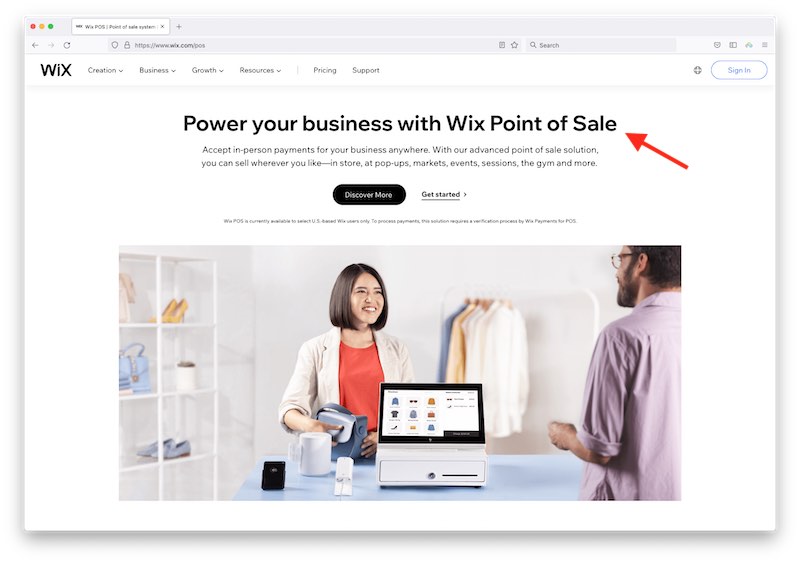
Unlike Shopify’s POS solution, however, Wix POS is only currently available in the USA and Canada, and only to ‘select users’ at that. If you live outside the US, you can still use the Square or SumUp options though (depending on your location).
It’s important to note however that with Shopify, you may need to invest in its ‘POS Pro’ add-on to get the most out of point of sale. The fee for this feature is not inconsiderable: $89 per month, per location ($79 per month if you pay upfront for a year).
Although Shopify’s built-in point-of-sale features (‘Shopify POS Lite’) cover the basics of selling in a physical location, and will be fine for merchants with simple needs, you will need the add-on if you want to:
- use an unlimited number of registers
- work with an unlimited number of store staff
- facilitate ‘buy online, collect in store’
- facilitate exchanges
- provide custom printed receipts
- define staff roles and permissions
- create purchase orders
- attribute sales to particular staff members.
With Wix’s POS system, you don’t have to worry about additional fees to get access to most of this functionality. You will still have to pay for hardware (and note that only Wix-approved hardware is supported), but there are no additional software costs to consider.
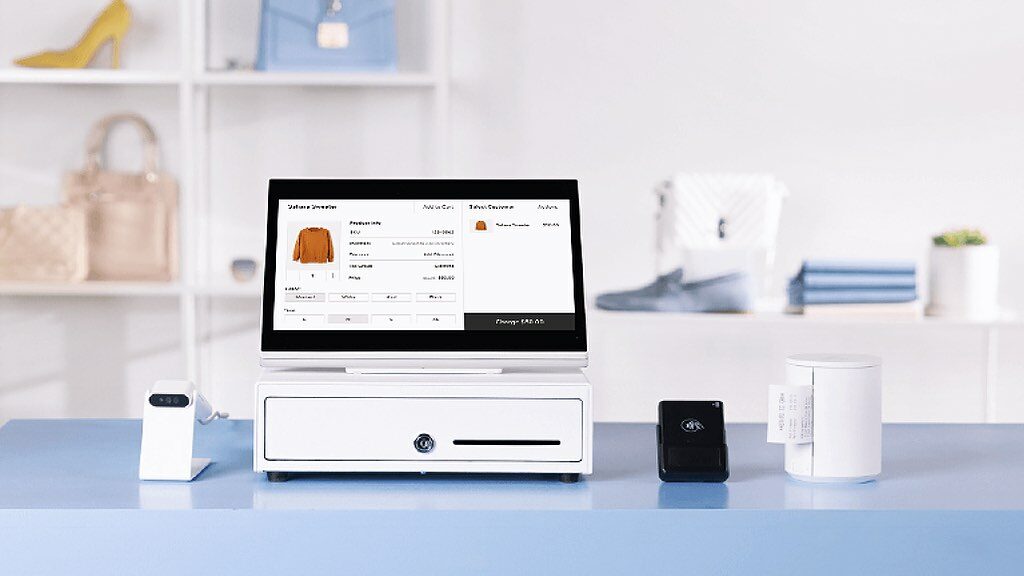
There’s no doubt that Shopify’s POS functionality is more established and more widely available — but depending on your requirements and location, you may be able to access POS features more cheaply with Wix.
Multi-currency selling features
You tend to make more online sales if you sell in the currency used by your store visitors.
So, if you’re selling in lots of different countries, it’s good to be able to let your potential customers choose their own currency — or, better yet, to present your products in your site visitors’ currency automatically.
Shopify facilitates full, end-to-end multi-currency payments. There are two ways you can accept them:
- via Shopify’s ‘Markets‘ feature — a built-in global selling tool that allows you to accept local currencies and specify language settings for different countries.
- by installing a dedicated third-party multicurrency app.
Both options let you present prices in a store visitor’s local currency and allows that visitor to check out using it. However, ‘Markets’ only facilitates payments via Shopify Payments (which as discussed earlier, is not available in all territories).
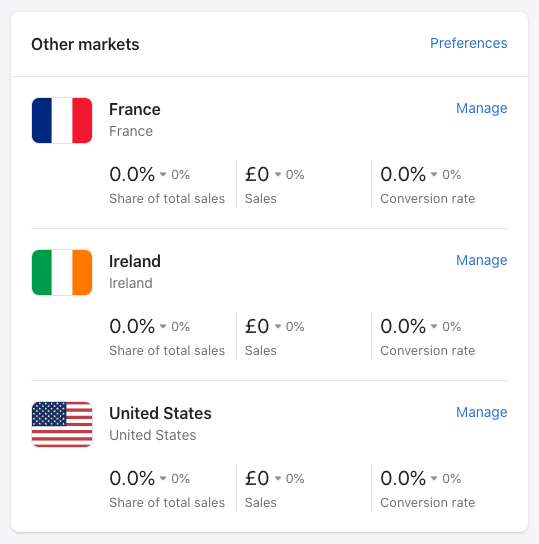
Although Wix does allow you to display prices in different currencies — via a currency converter drop-down menu — Wix online store visitors can’t yet check out in their own currency.
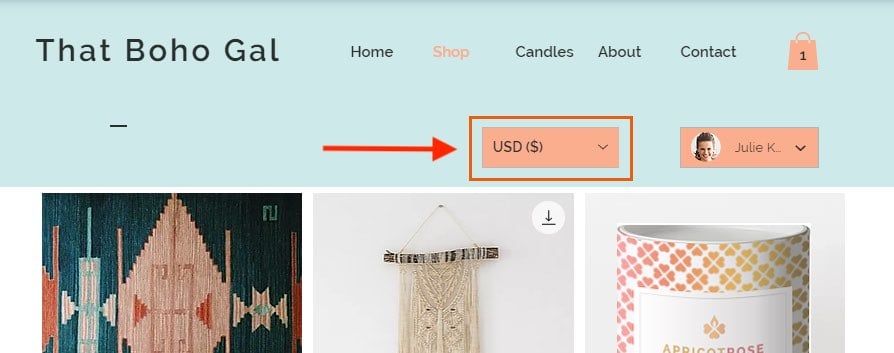
This matters because the checkout page is a crucial part of the sales process, and you don’t want anything present on it — such as a price in a foreign currency! — that could act as a barrier to sale.

For me, the lack of full multi-currency functionality in Wix represents one of the strongest arguments for using Shopify instead.
Multilingual features
Both Wix and Shopify allow you to create versions of your websites in multiple languages.
Shopify lets you create up to 20 different language sites, so long as you are on a Basic Shopify plan or higher.
On Wix, so long as you are building in the ‘Wix Editor’ version of the platform (i.e., rather than ‘Wix ADI’), you can enable ‘Wix Multilingual’ on any plan.
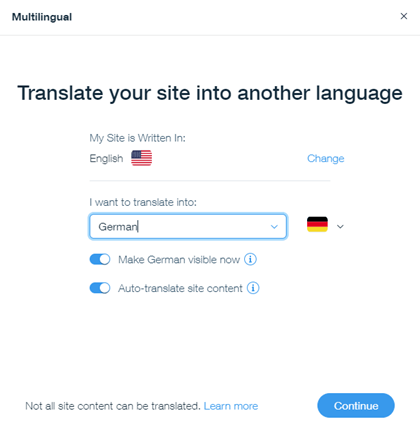
Once this is enabled, Wix lets you create versions of your site in over 180 different languages, so it’s a win for Wix here.
Abandoned cart recovery
Abandoned cart recovery is a key piece of ecommerce functionality — it allows you to identify store visitors who added an item to their cart, but didn’t complete a purchase. You can then send a follow-up email to those visitors (usually containing an incentive, like a discount code, to encourage them to complete the transaction).

The good news is that Wix and Shopify both feature this functionality, and it’s available on most of the Shopify plans (‘Basic’ or higher), and all Wix ecommerce ones.
Thanks to programmable ‘triggers,’ both platforms give you a lot of control over the conditions under which reminder messages are sent (and in the process make the abandoned cart saving features offered by competing solutions like BigCommerce and Squarespace look quite basic).
These triggers form part of ‘editable workflows’ that let you create if/then rules for sending your automated emails (see screenshot below for an example of this in action).

Shopify has a slight edge here however, because unlike Wix it also offers a ‘browse abandonment’ recovery feature. This lets you send emails to people who have browsed products on your store, but not added them to the cart.
(It relies on them having supplied you with their email address in a previous visit, however).
Shipping options
Both Shopify and Wix allow you to create a variety of shipping rules, letting you offer your customers:
- free shipping
- flat rate shipping
- shipping by weight
- shipping by price
- shipping by product
- local pickup.
You can also provide real time shipping quotes to your customers, where your online store connects to a postal service and displays a ‘live’ shipping price for your item.
Wix provides real-time carrier shipping quotes via USPS in the USA; real-time shipping quotes from other suppliers will involve additional costs — and you’ll need to connect the paid-for service ShipStation (or a similar app) to facilitate them.
Shopify’s built-in real-time shipping tool, “Shopify Shipping,” caters for more countries — United States, Canada, France, Australia, Italy, Spain and the United Kingdom — and postal services (see table below for details).
| Fulfillment location | Available shipping carriers for Shopify |
|---|---|
| United States | FedEx by Shippo, USPS, UPS (not available in Puerto Rico), DHL Express (continental US only) |
| Canada | Canada Post, Purolator, UPS |
| Australia | Sendle |
| United Kingdom | Evri, DPD, Yodel |
| France | Colissimo, Mondial Relay, Chronopost |
| Germany | DHL Paket |
| Italy | Poste Italiane |
| Spain | Correos |
For example, in the USA Shopify users can avail of real-time shipping quotes from DHL Express, FedEx (by Shippo), UPS or USPS, and discounts of up to 88%.
Insurance to the value of $200 is also provided on shipping labels bought via the Shopify Shipping service, so long as you’re on a ‘Shopify’ or higher plan. If you need more, you can purchase it separately from Shopify at a price of $0.89 per $100 of coverage, up to a maximum of $5,000.
(Note however that this insurance service is currently only available to US based users, and that it’s a ‘BETA’ feature).
If you’ve negotiated your own shipping rates with carriers, and wish to display those instead, Shopify also lets you do this — but additional charges are involved. You can avail of this functionality by upgrading to a ‘Shopify Advanced’ or ‘Shopify Plus’ plan, paying an additional monthly fee or paying for your Shopify plan on an annual basis.
And, as with Wix, you can use ShipStation with Shopify to offer real-time quotes for other suppliers.
The bottom line on shipping: because it is more flexible in terms of the suppliers it allows you to work with for real-time shipping quotes, and offers generous discounts for this servicintee in certain countries, it’s a win here for Shopify.
Tax calculations in Wix and Shopify
A key challenge for owners of ecommerce businesses is getting taxes right — if you’re selling in different jurisdictions or have a particular tax registration, ensuring that the right taxes are being charged on your products end up being a complicated and time consuming task.
The good news is that Wix and Shopify both let you calculate and apply tax rates to your products automatically. However, they do so in quite different ways.
If you’re a Wix user, you use the third-party ‘Avalara’ app to apply the correct rate — and you have to be on a ‘Business Unlimited’ or ‘Business VIP’ plan to do so.
On the plus side, the Avalara app gives you the ability to apply the correct taxes for just about any country — but on the down side, you are limited to a certain number of calculations per plan (100 per month on the ‘Business’ plan; 500 on the ‘Business Elite’ plan’, and unlimited on the ‘Enterprise’ plan). These limits won’t be adequate for users with a large number of sales per month.
With Shopify, automatic tax calculation is a built-in feature. Like Wix, limits are applied to calculations, but they are more generous: you can use Shopify’s tax features for free so long as your annual sales are under $100,000. After that, a transaction fee of between 0.25% and 0.35% is applied to each sale involving a tax calculation (depending on plan).
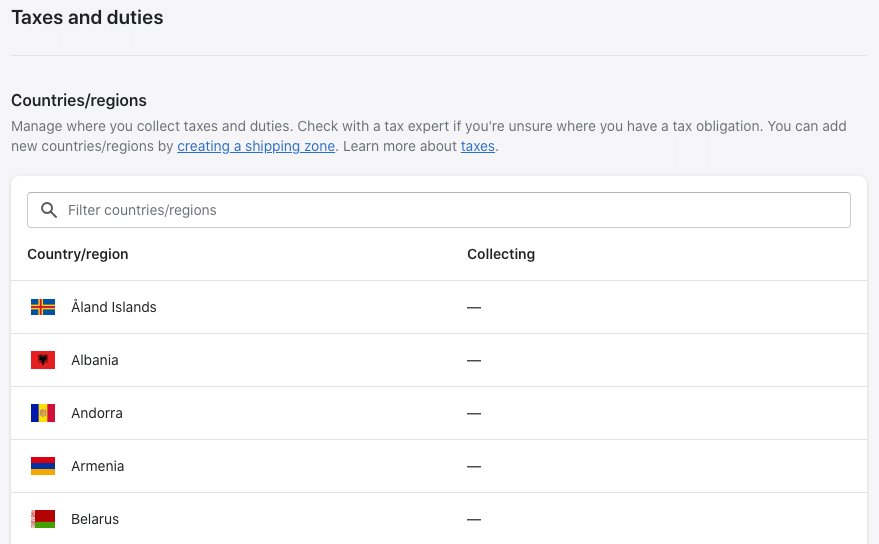
However, if you want to use it with registration-based taxes (i.e., covering VAT / state taxes etc.), you’ll need to be based in one of the following territories:
- Australia
- Canada
- New Zealand
- Norway
- Singapore
- Switzerland
- the European Union
- the United Kingdom
- the United States.
So, of the two products, Shopify is unquestionably the better option for tax calculations (especially if you operate from one of the countries listed above).
Now, let’s take a look at integrations and apps.
While you’re here, download our free ecommerce e-kit
For a limited time, we’re offering our readers some excellent free tools. Sign up free to immediately receive:
- our online store comparison chart
- a downloadable cheatsheet on how to create an online store
- our SEO, blogging and ‘how to start a business’ cheatsheets
- extended free trials and discount codes for essential business apps
- our latest tips on ecommerce and growing a business
Integrations and apps
Both Wix and Shopify provide app stores featuring a range of add-ons for your site — these let you add or improve both platforms’ functionality considerably.
In both stores you’ll find apps that handle key tasks like product reviews and ratings, digital downloads, gift cards, dropshipping, tax calculations and accounting tasks.
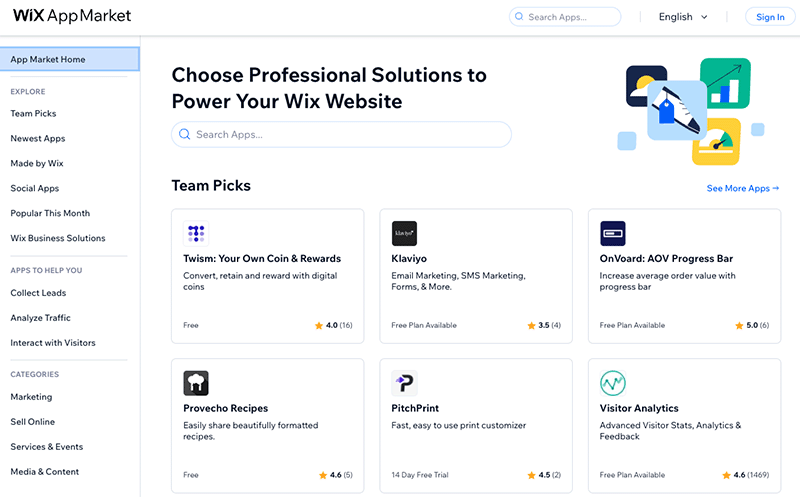
The Wix and Shopify app stores are a bit different in nature however: the Wix app store is mainly stocked with apps that generally let you add additional features to your site, while the Shopify app store is as much about integrations — for example with email marketing apps, accounting apps and CRM apps — as it is about add-ons.
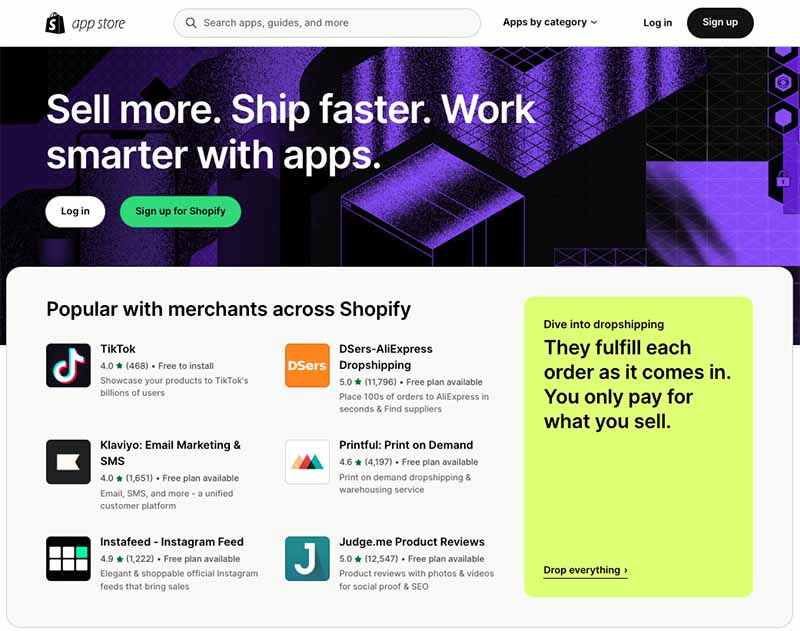
Ultimately, the quantity of apps and integrations available for Shopify dwarfs that of Wix — there are 13,000+ apps for Shopify versus 1,184 for Wix — so the overall winner in the integrations and apps department is definitely Shopify.
Email marketing tools
Wix and Shopify both come with bundled email marketing tools.
In Wix, you can send e-newsletters to an audience of 200 subscribers per month for free; if that’s not enough for you, you can upgrade to Wix’s paid-for email marketing tool (note: this was formerly known as ‘Wix Ascend’).
The latter lets you broadcast more emails per month — between 500 and 1,000,000 depending on plan — and make use of a variety of automations (emails that are triggered in various ways by actions made by visitors on a Wix site, like purchases or form completions).
Oddly, Wix doesn’t make pricing details for its email marketing features publicly available, but if you have a Wix account you can view the relevant fees by logging into your account. Here’s what I saw when I did just that:
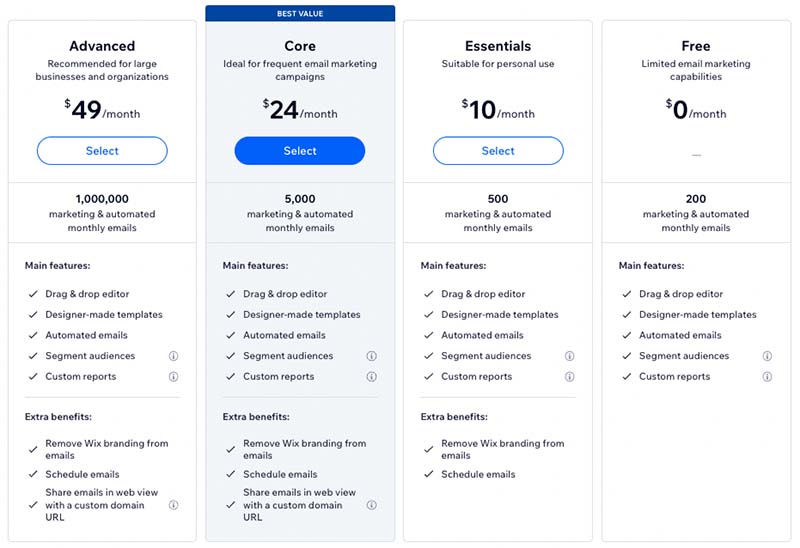
Shopify’s recently introduced email marketing tool, ‘Shopify Email,’ lets you send 10,000 emails per month for free, with a $1 fee applying to every additional 1,000 messages you send.
(This fee can be reduced to $0.65 or $0.55 if you’re a high-volume sender. You can avail of these lower fees if you email 300,000+ or 750,000+ subscribers per month respectively).
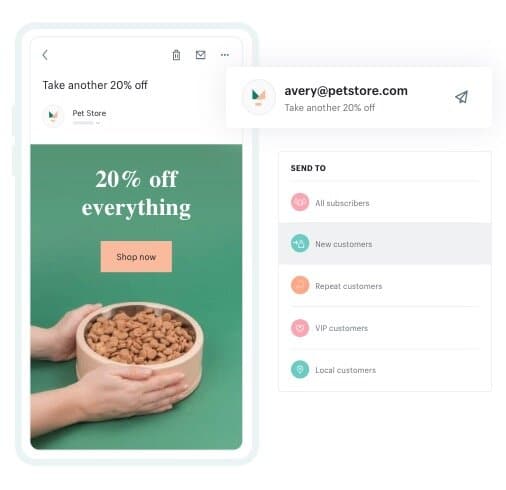
Now, the email marketing functionality available in both platforms doesn’t yet rival that which you’ll find in dedicated email marketing tools — for example, you won’t find the sort of advanced autoresponder features you get in platforms like GetResponse or Mailchimp.
But that said, Wix does offer some pretty decent email automation features on its email marketing plans — and Shopify recently made some improvements in this department too, letting you create ‘if then this that’ rules that send emails automatically based on specific user actions.
So all in all, many users may find both Wix and Shopify’s email marketing tools very useful indeed. And, if more advanced features are required, it’s easy enough to integrate more professional email solutions like GetResponse, AWeber and Campaign Monitor into both platforms (this is slightly easier to do with Shopify though, thanks to a wider variety of dedicated integrations for these sort of tools being available).
However, because Shopify lets you send considerably more free emails per month to your subscribers than Wix — 10,000 vs 200 — it’s fair to say that the winner here is definitely Shopify.

SEO tools in Wix vs Shopify
A key question for prospective users of Wix and Shopify is this: how good are the search engine optimization (SEO) features?
Well, both products handle the basics of technical SEO well, allowing you to easily tweak page titles, meta descriptions, headers and robots.txt files. However, I’d argue that in most respects, Shopify outperforms Wix in the SEO department, especially where mobile search is concerned.
First, and as discussed above, Shopify sites are fully responsive — Wix’s are not. Given that Google’s algorithm has a preference for responsive sites, this gives Shopify an immediate edge when it comes to SEO.
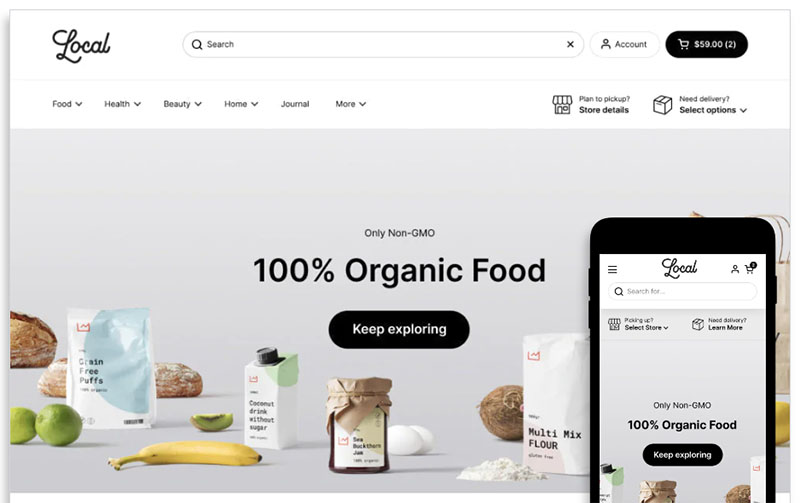
Second, any time you change a page or product URL in Shopify, it automatically creates a 301 redirect for you (a 301 redirect lets search engines know that a page has moved location — forgetting to do this can have a very negative effect on search rankings, especially where popular pages of your site are concerned).
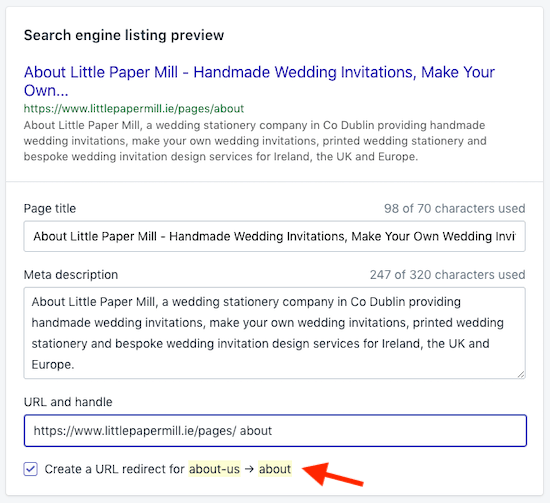
In Wix, automatic redirects are only created if you’re on a paid-for plan (this is not the end of the world though really). On the free plan, you’ll need to create this redirect yourself, using a different section of the interface to do so.
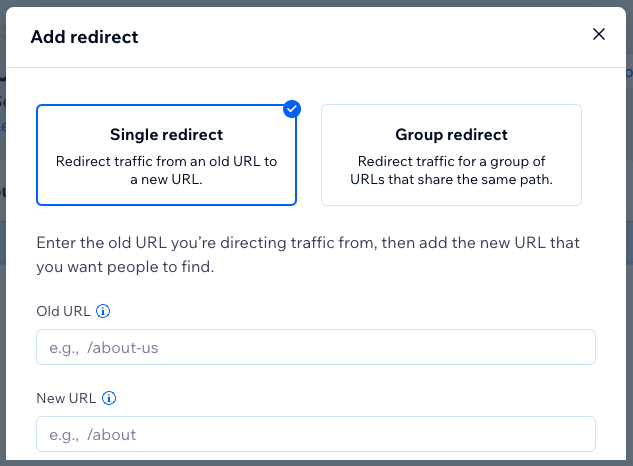
Third, it’s arguably easier to get a Shopify store to meet Google’s new ‘Core Web Vitals‘ requirements. Core Web Vitals are a set of targets relating to the speed, responsiveness and visual stability of a website; and sites that meet them can receive preferential treatment in Google search results.
The Shopify app store provides a range of apps that help you meet Core Web Vitals targets; and the fact that its template designs are responsive gives the platform a built-in advantage on this front too.

Additionally, a dedicated Core Web Vitals report in your Shopify dashboard (pictured above) makes it easy to keep tabs on how your site is performing against these targets.
And finally, Shopify lets you use the excellent ‘Yoast’ app to sense-check your SEO efforts. Yoast is an industry-standard SEO tool that examines your site’s content and provides an easy-to-action list of steps that could improve its performance in search results (the only other platform that currently lets you use Yoast is WordPress; Shopify is unique amongst hosted website builders in letting you — albeit for a fee — integrate it with your store).
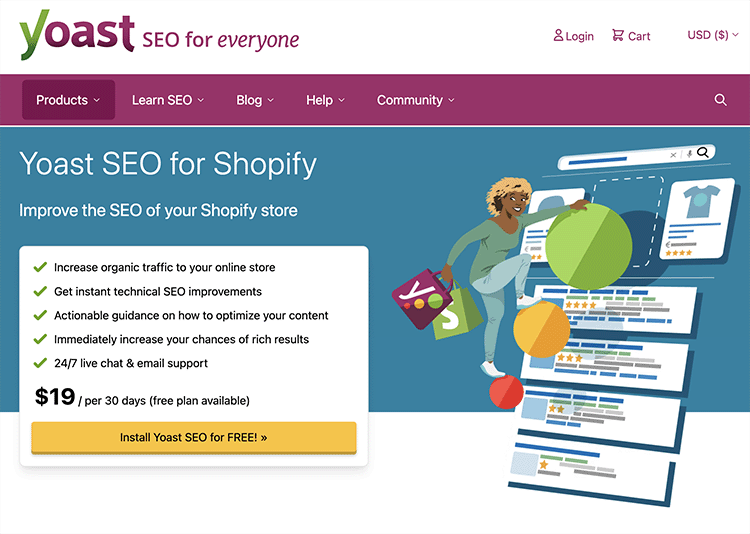
Wix does provide a feature which SEO newbies might find useful however — ‘SEO Setup Checklist’ (formerly ‘SEO Wiz’). This is a wizard-style tool which asks you various questions about your site and comes up with a checklist containing SEO recommendations for you to follow.
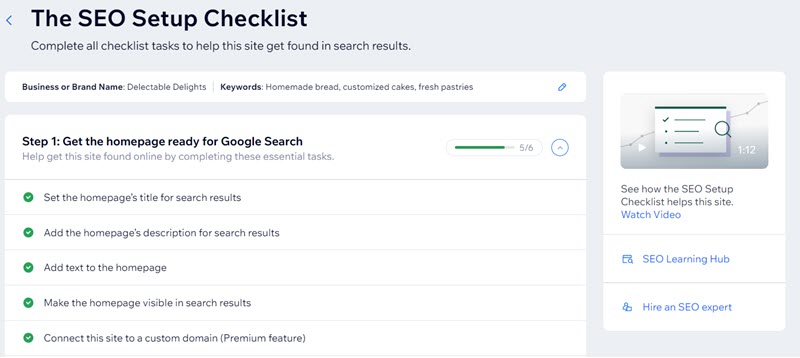
This tool should not be considered as a substitute for working with a professional SEO expert, but it’s a good starting point and a way to get acquainted with the principles of SEO.
Recently, Wix introduced an ‘SEO Assistant’ tool that reviews your copy and suggests SEO tweaks you should make to them. This works in a similar way to Yoast — and makes up to a degree for the lack of an integration with it — but you should note that you can only use the feature on blog posts.
Wix is also to be commended for its ‘SEO Dashboard’ feature. This is basically a deep integration with Google Search Console, Google’s suite of tools that help website owners improve their rankings. The dashboard lets you view all your Search Console data without leaving the Wix environment.
Finally, it’s worth remembering that regardless of which of these two platforms performs best from a technical SEO perspective, your site will only ever rank in search results if good keyword research has been applied, its content is high in quality and it has a lot of links pointing to it.
To help you with this, Wix gives you a built-in integration with Semrush, one of the most popular keyword research tools on the market. This lets you perform 10 pieces of keyword research every 24 hours for free (more if you are on a paid-for Semrush plan).
Ultimately I’d argue that either a Shopify or a Wix site can rank well in search results if the content and link building strategies are strong enough. But due to the fact that it meets Google’s technical SEO expectations more effectively (both in terms of Core Web Vitals and responsive templates), the better-performing option for those working in highly-competitive niches will probably be Shopify.
📚 Related SEO resources
- If you’d like to learn more about how to optimize a Wix or Shopify site for search engines, check out our dedicated Shopify SEO and Wix SEO guides.
- If you’re interested in learning about the tools you’ll need to create effective SEO campaigns, check out our Semrush review, our Semrush pricing guide, our Moz vs Semrush comparison, our Ahrefs vs Moz guide, our Ahrefs review and our Ahrefs vs Semrush shootout.
Security
A key advantage of using a hosted solution like Wix or Shopify — as opposed to using a self-hosted platform like WordPress — boils down to security. Both companies are technically responsible for it; you don’t have to worry about keeping themes or plugins up to date.
Both platforms give you:
Wix has one important edge in this area however, because it also backs up your site periodically. With Shopify, you’ll need to use a third-party app to do this, or export your product data to a CSV file from time to time.
Customer support
Another big advantage of using a hosted solution like Wix or Shopify over a self-built, hosted one is that you get customer support included.
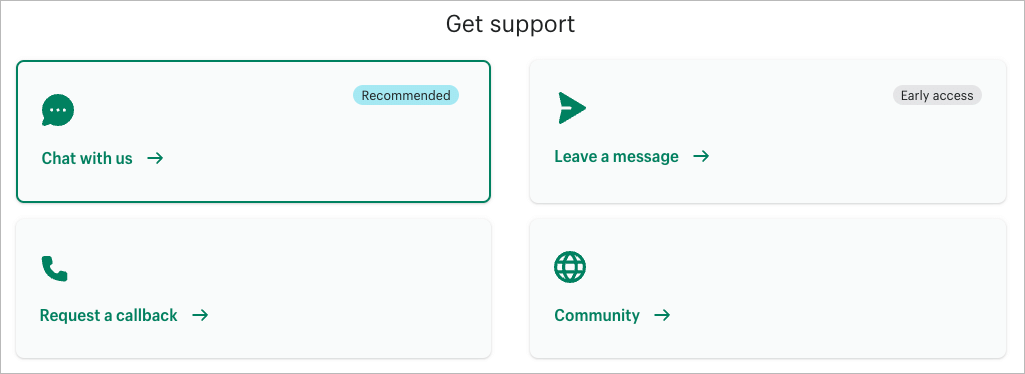
Wix has an advantage here in terms of the number of support channels available: it gives you access to support via phone, chat and email, while Shopify restricts you to just chat and email.
(Phone support with Shopify is reserved for merchants on its ‘Shopify Plus’ plan).
There are also extensive ‘knowledge-base’ resources for both platforms that you can browse, and community forums that you can pose questions to.
Both Shopify and Wix make it harder than you might like to actually find any contact details, however: when trying to contact both companies’ support teams, I was repeatedly forced to search for answers to my query on their help portals before any contact information was displayed.
I understand the rationale behind this approach (encouraging the user to solve their own problem without recourse to an agent is a cost-saver!), but I’m not particularly a fan of it.
A few other things worth bearing in mind regarding customer support for both platforms are as follows:
- If you purchase a premium template on Shopify (i.e., as opposed to using one of the bundled free themes) you may need to contact a third-party developer for support with technical issues relating to this template. How good this support is will depend on the provider of the template.
- Wix uses a ‘request callback’ approach to phone support.
- Shopify’s help web pages are available in a few more languages — 18 to Wix’s 13.
- 24/7 customer support is available for both platforms in English, but if you need support in a different language, you may encounter more restrictive options and support hours.
- Oddly, Shopify’s support materials don’t feature any screenshots, which makes them a little less user-friendly than Wix’s.
Wix vs Shopify: the verdict
Overall, Wix is the more obvious choice of the two platforms for those wishing to build a ‘general-purpose’ website. Its drag and drop editor, blogging tools, data capture features and wider range of templates make it more suitable for users who place equal emphasis on content creation and ecommerce.
For professional ecommerce applications, the better choice is definitely Shopify. This is because its advanced selling tools, POS options, dropshipping features, multi-currency selling functionality and huge range of apps make it a much more sophisticated option for anyone wishing to build an online store. Wix is catching up fast, but as things stand, Shopify is the more powerful ecommerce platform.
Of course, it’s important to get your own take on which platform is right for you, and I encourage you to try them both yourself. You can access the trials for both platforms using the below links:
I’ll leave you with a summary of the key pros and cons of both platforms — and do leave a comment if you have any questions or observations of your own.
Pros and cons of Wix vs Shopify
Reasons I would use Wix over Shopify
- Wix provides an entirely free plan that doesn’t have a time limit (but you should note that you can’t sell with it).
- Wix is a better tool for creating a ‘general-purpose’ website. It’s easier to add features like galleries, forms and events to a Wix site.
- The Wix platform is generally more affordable than Shopify.
- Wix doesn’t charge transaction fees if you use a third-party payment gateway.
- A much wider range of bundled templates is available in Wix than in Shopify.
- Wix lets you translate your site into considerably more languages than Shopify.
- You can feature blog content on static web pages more easily in Wix.
- Wix provides built-in tools for managing cookie consent (for certain script types) in a GDPR-compliant way.
- Wix’s product options / variants limits are more generous than Shopify’s.
- Its built-in email marketing features are stronger.
- It’s easier to create bespoke forms and capture data in Wix than in Shopify.
- Wix gives you basic autosave / archive functionality; Shopify doesn’t.
- Wix gives you a free domain name if you pay upfront for a year’s service — Shopify doesn’t.
- Phone support is provided by Wix but not by Shopify.
👉 Free trial: Try Wix for free here.
Reasons I would use Shopify over Wix
- Shopify’s templates are fully responsive; Wix’s aren’t.
- You can let users check out in multiple currencies with Shopify — you can’t with Wix.
- Shopify’s dropshipping features are more extensive.
- Shopify is better for point-of-sale applications — all of its plans are bundled with really strong POS functionality.
- Shopify’s product categorization options are more flexible and sophisticated.
- SEO functionality is better in Shopify than Wix.
- You can use the platform extremely cheaply for your first month of service.
- Shopify’s automatic tax calculation features are stronger, especially where VAT MOSS is concerned.
- You can switch templates easily with Shopify — this is not the case with Wix, which forces you to rebuild your site if you want to move to another template.
- There is a much wider range of apps and integrations available for Shopify.
- Importing and exporting content and products is more straightforward in Shopify.
- Although Shopify’s interface is less flexible than the Wix equivalent, it’s arguably easier to use.
- A wider range of online payment gateways is available for Shopify.
- The Shopify ‘Buy Button’ lets you use the platform to add a shopping cart to existing websites or social media profiles (and is available for as little as $5 per month via Shopify’s ‘Starter’ plan).
- Shopify support is available in more languages.
👉 Free trial: Get a special, extendable trial of Shopify here.
The alternatives to Wix and Shopify
If you feel that neither Wix or Shopify are the right ecommerce platform for you, there are lots of alternative solutions available. (Our Shopify alternatives and Wix alternatives articles contain a list of the key ones).
For professional merchants, I’d suggest that BigCommerce is well worth investigating as a key alternative to Wix and Shopify — it is a professional ecommerce tool with a feature set that is comparable to Shopify’s.
(In fact, several key features that require an app purchase in Shopify are available out of the box in Bigcommerce.)
Check out our BigCommerce vs Shopify comparison and our BigCommerce review for more details, or watch our BigCommerce vs Shopify shootout on YouTube.
For general website building purposes, Squarespace is definitely worth a look — it offers a really easy-to-use interface and better blogging tools than either Shopify or Wix, and also comes with a good range of ecommerce tools. Integrating it with third-party services is a bit harder however, and the ecommerce functionality isn’t as strong as Shopify’s.
For more information about Squarespace, do check out these resources from Style Factory:
If you’re on a very low budget, and only selling a few products, you could consider Big Cartel or GoDaddy — but you should note that their ecommerce features are quite limited compared to those of Shopify and Wix.
For more details, you can read our Big Cartel vs Shopify comparison here, our full Big Cartel review here and our Shopify vs GoDaddy shootout here.
Because of its free plan, Square can also be a good choice for merchants on a very low budget; it’s also a very good point-of-sale solution. Take a look at our Shopify vs Square comparison for more details about this product.
WordPress is also a good option for selling online (particularly when used in conjunction with WooCommerce); however, to get the best ecommerce setup with WordPress, we usually recommend investing in some developer support.
Check out our Shopify vs WordPress comparison, our Wix vs WordPress comparison and our Squarespace vs WordPress comparison for more insights on how WordPress stacks up against popular hosted ecommerce solutions.
For merchants looking to create an extremely ‘bespoke’ store, Webflow is worth a look – this rather unique platform gives you a huge degree of control over the design of your store, and access to a wide range of animations too. You can read our Webflow review here (our Webflow vs Wix and our Webflow vs Shopify comparisons may also be of interest here.)
Finally, you could also consider using online marketplaces like Amazon, eBay or Etsy to build your online store. Although these kinds of platforms work in a very different way to hosted website builders like Wix and Shopify, thanks to their existing (and very large) userbases, they can provide a very effective way to sell products online.
If you’re interested in learning more about using Amazon, eBay or Etsy to build an online storefront, you can take a look at our Shopify versus Amazon, Shopify versus eBay and Shopify versus Etsy comparisons.
Wix and Shopify — at a glance feature breakdown
| Wix | Shopify | |
| Pricing | $16 to $159 per month | $5 to $2,300 per month |
| Templates | 920 (all free) | 230 (13 free) |
| Responsive templates | Partially | Fully responsive |
| Checkout type | One-page | One-page |
| Access to site code | None | Extensive |
| Payment gateways | 97 | 300+ |
| Products you can sell | 50,000 | Unlimited |
| Product options | 6 | 3 (without app) |
| Transaction fees | None | None, but only if using ‘Shopify Payments’ |
| Apps | 1,184 | 13,000+ |
| Dropshipping apps | 65 | 638 |
| Email marketing | 200 free messages per month | 10,000 free messages per month |
| Userbase (source: Builtwith.com) | 8.6m websites | 5.5m websites |
| Multilingual sites you can host | 180 | 20 |
| Multi-currency selling | Partial | Full |
| Free domain | With annual plans | No |
| Free trial | 14 days | 3 days (but extendable to 3 months for $1) |
Comments (37)
Great article, thanks.
I have been researching moving away from WIX for my store as the performance is pretty average and I am on a high plan to get the extra marketing emails. I know it’s a tricky thing to evaluate but with just 200 products it can take 20-30 seconds to just list the products when you want to do updates on them, then when processing orders and adding tracking details etc the delays are also pretty average.
I guess these are some things that are impossible to know until you use the systems for processing orders and managing your products, but it’s these delays that are causing me to look at other products.
Thanks for the very insightful review, I’m still not convinced about which product is better though, I think I will have to do the Shopify trial and see how it works first.
thank you Chris!!!
Hello Chris, that was very insightful and helped me to opt for Shopify for my online grocery store ???? One question. Does Shopify allow you to advertise the URL shop link on other social media platforms such as Instagram, Facebook, Twitter? Thanks for your help!
Hi Cat, you should be able to post your Shopify store URL anywhere yes. You can also connect Facebook and Instagram to your Shopify store and sell products from it directly via those platforms’ own ecommerce systems. Hope this helps?
Hi Chris, This was a very informative article! I just have 1 question regarding Shopify. If you want the “extras”, features etc, how costly is each app per month? This could cost someone a fortune monthly for extras? For example, product options and variants, third party apps for abandoned carts etc.
Thanks Tara. It really depends on the apps you’re buying – yes, some can be quite pricey and add to your monthly outgoings quite a bit (it really depends on the app and your needs). But a lot of them don’t involve charges until you exceed a certain amount of usage per month. And unless you require a particular piece of bespoke functionality, you’ll often find that you can make do with the in-built apps that Shopify provides.
The same issue applies to Wix really in quite a few cases. Depends on the feature you’re looking for, really!
Hope this helps?
Hi Chris,
What do you think about Ecwid, in general, and compared to Wix/Shopify, for e-commerce? I saw some posts that highly recommended Ecwid for building an online store.
Thanks Arik
Hey Arik! Thanks very much for your question. We have an Ecwid review at https://www.stylefactoryproductions.com/blog/ecwid-review and a Shopify vs Ecwid comparison at https://www.stylefactoryproductions.com/blog/shopify-vs-ecwid
I hope this helps! Many thanks Chris
Hello! Can you build a stand alone website with e-commerce on Wix with the basic Business, Pro and Unlimited plans? Could you use the Shopify basic plan ($29) to sell through an instagram page? Just getting started, trying to run a basic online e-commerce shop and do some in-person sales. Thanks
Hi Candace, thanks for your query!
To build an online store with Wix, you’ll need to make sure you’re on one of its ‘business and e-commerce’ plans (in the US that’s Business Basic, Pro or VIP — names in other countries can be slightly different).
The $29 Shopify plan will let you sell on Instagram, yes – and it facilitates in person sales too.
Hope this helps!
Can build the storefront on with Wix’s Editor X and integrate it to the backend of shopify?
Hey Rita, you could use a Shopify ‘buy button’ in conjunction with a site built on Wix Editor. However, it would mean extra costs and you might find that you get more e-commerce functionality by just using one of the platforms exclusively.
I’m yet to take a look at Editor X’s e-commerce capabilities in depth, but it definitely offers a built in online store feature. Using that would probably be more beneficial than trying to add Shopify into the mix.
Alternatively, you could just use Shopify to build a standalone store; because it’s a dedicated online store builder, its e-commerce functionality is very strong. Hope that helps!
Hello, I want to sell in Japan, which platform do you recommend. Thank you very much.
Hi there – for me, if online selling is the main aim of your website, Shopify is better than Wix in nearly all respects. Shopify Payments works in Japan, which means you should be able to avoid transaction fees there, or use it for multi-currency selling. Hope this helps!
Hello,
Firstly, thanks a lot for this comprehensive comparison between Wix and Shopify, I am planning to build a fashion e-commerce store and limit it to the United Arab Emirates in the beginning, my question: Can I set the limit of the country in Shopify? And in the future, if I decide to widen the sale to other countries or eventually open it up worldwide, is this possible?
Many thanks Raby
Cheers Raby! I think the best way to do this is in Shopify simply to create just one shipping zone — for the UAE.
Thanks for your information. I have a questions. I tend to produce my products in Mexico and register my business in Canada, and sell them online, with international shipment (US, Canada, Mexico …) Is that possible ? and which platform is more suitable. WIX or Shopify
Hi Annie, my view is that if e-commerce is your main aim then Shopify is the better solution – it’s basically designed for e-commerce whereas Wix is a more general website building product with some e-commerce features on the side. From the sounds of it, I think you’d be able to do everything you mention in your comment using Shopify easily enough.
I’ve built my site on Wix because I like having the creative control. With Wix so far it looks like I’ll be able to have an e-commerce site, attach my YouTube videos, and build a community within my page. Does Shopify allow all of that without you buying a template? Also, Wix customer service has been great and I can request the same tech to help me through email and they remote in to your site to assist you. Does Shopify provide that level of customer service?
Hi there Shawnese, thanks for your comment! Shopify does allow all that yes — although there is a smaller range of bundled templates to play with. Regarding support, I think it would depend on the query as to whether you ended up dealing with the same person, and same goes for accessing your site remotely. Really the main reason to choose Shopify over Wix is that the ecommerce features are much better (especially if you plan to sell internationally); Wix is generally better for site owners that have a mix of different needs (it’s easier to do things with galleries, videos, forms etc. in Wix).
Thanks for a very imformative article. I have already built a site for a client on Wix but just checking if you are saying that only SHOPIFY gives you a Buy Now button option on social media or does Wix has an option to take you from eg Instagram to the online shop?
Thanks for your question Sue – yes, Wix has an option to sell via Instagram. Full details here: https://support.wix.com/en/article/wix-stores-connecting-your-instagram-account
But there isn’t really an equivalent of the Shopify ‘Buy Button’, no.
Hi. I’m stuck between which provider to use. I’m going to sell locally grown flowers, b2c and b2b. And occasionally host webshops and in the future online courses. I’m leaning towards Wix for a more content based website.
Thanks Marcus. Wix does give you more tools for creating content, that’s true, and if your site was a brochure site I’d recommend Wix over Shopify. However if ecommerce is the key goal you’ll find that the selling features are considerably stronger in Shopify.
It’s getting better at the content marketing side of things too – the blogging functionality is fine, and the ‘Dawn’ theme (or a paid-for OS 2.0 theme) gives you access to a drag and drop editor.
I’d suggest trying both out, seeing how you get on with creating some content / adding some test products, and then making a decision based on which you prefer.
Could you post a section on back officer accounting integrations, I understand they both work well with QB, how about others? Thanks,
Hi Mike, both products also work with Xero, which is I guess the other big hitter in the accounting apps market.
For a full list of accounting apps that both tools work with, I’d suggest checking out their respective app stores:
https://apps.shopify.com/ https://www.wix.com/app-market
Hope this helps? Thanks for checking out our comparison!
Hey – just a quick question If i wanted to sell in Australia and the UK which platform would you recommend? Thanks
Hey Chris! Thanks for your query. I’d make sure to pick a platform that facilitates selling in multiple currencies. Of the two products under discussion here, Shopify does this better. BigCommerce is also worth a look too as its standard multi-currency selling tool automatically detects location (something which you’ll need an app for on most Shopify plans). More info at https://www.stylefactoryproductions.com/blog/bigcommerce-vs-shopify
I was told Shopify shipping prices with the couriers are in bulk so individual business owners piggy back from all of Shopify’s customers so it’s cheap. (ex. if I were to go straight to FedEx for a rate vs. Shopify getting a bulk discount for all its clients).
Is this the same for wix? I have a wix place holder store and need to transition into ecommerce. Wondering if wix has this bulk discount with the couriers?
Hi Kyu, Wix offers a similar service to US merchants — with USPS. Depending on the plan, discounts of up to 74% are available. Hope this helps?
Wix is currently offering a 50% discount on their ecommerce plans until the end of today…for the business unlimited it’s 13.50/mo (3 yrs is 11/mo) I think becuase I am selling items that I make/assemble this is probably better than Shopify considering it’s more $$$ and seems to give me less flexibility with site design…?
Hi Ed – you do get less flexibility with site design in Shopify (unless you purchase a ‘drag and drop’ page builder app) BUT you do get a responsive (automatically mobile friendly) site, which brings with it SEO advantages and often a better user experience. That said, Wix can work out a lot cheaper than Shopify whilst still offering a lot of useful functionality. I’d zoom in on the ‘Reasons to choose Wix over Shopify’ and the ‘Reasons to choose Shopify over Wix’ sections in the above post when making your final decision. Good luck with your project!
Great article! I read it from top to bottom.
I have to develop 3 websites for companies and now the question for them is "Do you see your company selling online in 2 years?"
If yes -> ShopifyNo -> Wix.
Fantastic article, extremely helpful!Thankyou very much from New Zealand
No worries Jas – thank you for the kind words and glad you found it useful! Good luck with your project.
Thank you for this very indepth discussion Chris. Very helpful indeed 🙂
I was wondering whether to use Shopify Lite on an existing Wix website (currently non e-commerce store) in order to save paying for the Wix e-commerce plan (especially in this difficult time for many businesses where we need to look quickly to an online selling model).
This is for a business that only sells 10 – 30 products.
Reading this I can see a larger e-commerce store with hundreds or more products would be better with shopify. However, the site I am thinking of is a small, very content rich site that would like to sell a small number of products.
Therefore I could either a) upgrade to Wix e-commerce plan and connect to a local payment gateway provider here in my country, OR add Shopify Lite, allowing us to sell off the website as well as our facebook page…mmm?!
Hi there Kim – I’m sorry for the delay in replying to this comment; it’s been a bit of a crazy time here at Style Factory over the past few weeks because in the light of the COVID-19 crisis, we’ve been getting a lot of extra enquiries from people creating online stores.
I think to be honest if you already have a Wix store, you’re probably better off using the built-in e-commerce features. Things will be more tightly integrated and you can also make use of some of Ascend’s interesting automation features to market your products.
Wix seems to be rolling out selling on Facebook too now: https://support.wix.com/en/article/creating-a-facebook-shop-in-wix-stores
But that said, there’s a rather vague statement saying this feature is ‘not yet available to all users.’ I’ll keep my eye on this for a future update of the review 🙂
Good luck with your project!